
Fundamentals of Management, 10e (Robbins)
Chapter 1 Managers and Management
1) Which of the following is a common myth about the study of management?
A) Management is just common sense.
B) Managers need to be well disciplined in all of the business areas.
C) Managers are found in all types of organizations, large and small.
2) An organization is ________.
A) the physical location where people work
B) any collection of people who perform similar tasks
C) a deliberate arrangement of people to accomplish some specific purpose
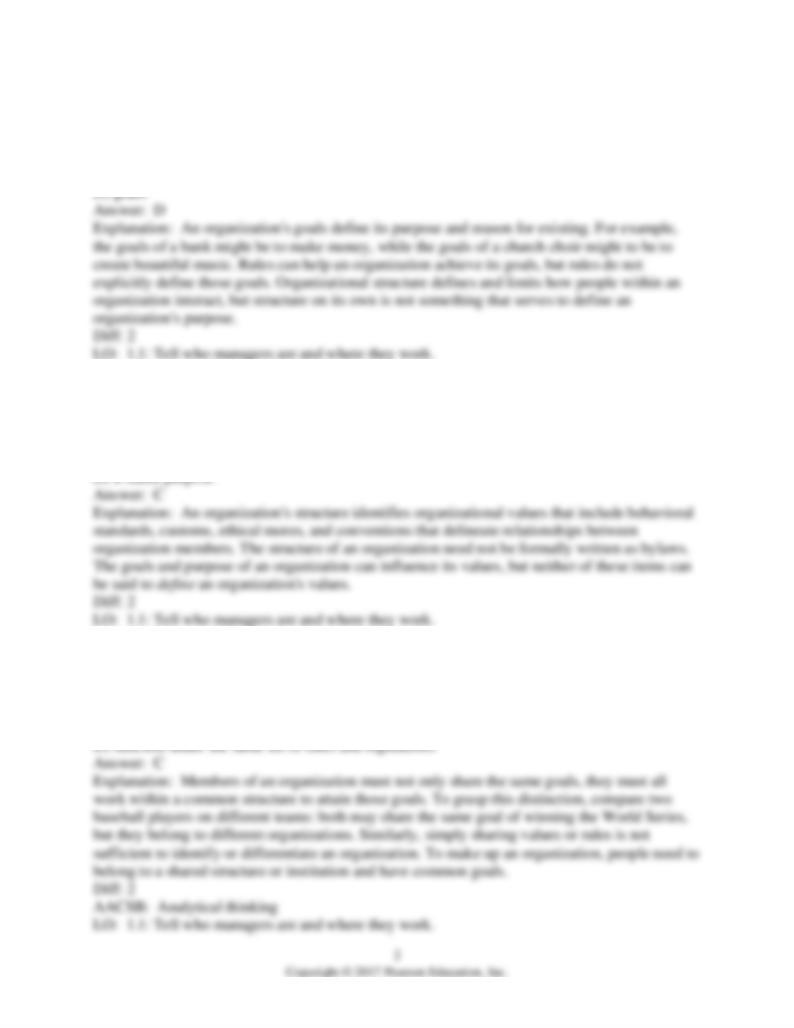
3) All organizations have ________ that define(s) the organization's purpose and reason for
existing.
A) limits
B) rules
C) structure
4) One of the common characteristics of all organizations is ________ that define(s) rules,
regulations, and values of the organization.
A) a set of written bylaws
B) an explicit goal
C) a systematic structure
5) A fraternity is an example of an organization because it is comprised of people who
________.
A) share the same values, traditions, and customs
B) share the same goals and values
C) share goals and function within a common structure
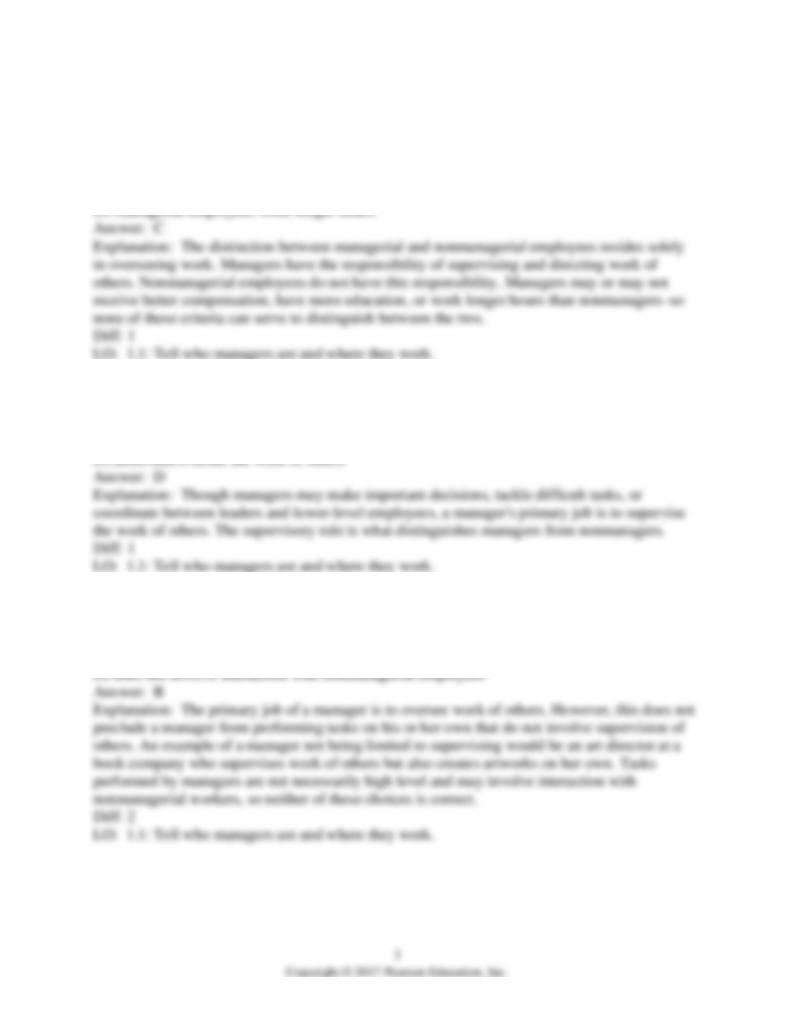
6) Which of the following is a key difference between managerial and nonmanagerial
employees?
A) Managerial employees receive higher pay compensation.
B) Nonmanagerial employees have less formal education.
C) Nonmanagerial employees do not oversee the work of others.
7) The primary job of a manager is to ________.
A) make decisions that help an organization grow
B) tackle tasks that are too difficult for nonmanagerial employees
C) coordinate between organization leaders and ordinary employees
8) The work of a manager ________.
A) is strictly limited to overseeing and monitoring the work of others
B) may involve performing tasks that are not related to overseeing others
C) involves only high-level tasks that require a sophisticated skill set

9) Supervisor is another name for which of the following?
A) team leader
B) middle manager
C) first-line manager
10) Which of the following types of managers is responsible for making organization-wide
decisions and establishing the plans and goals that affect the entire organization?
A) team leader
B) top manager
C) department head
11) Which is an important job responsibility for a middle manager?
A) defining the organization's long-term goals
B) translating goals defined by top managers into action
C) helping top managers define goals
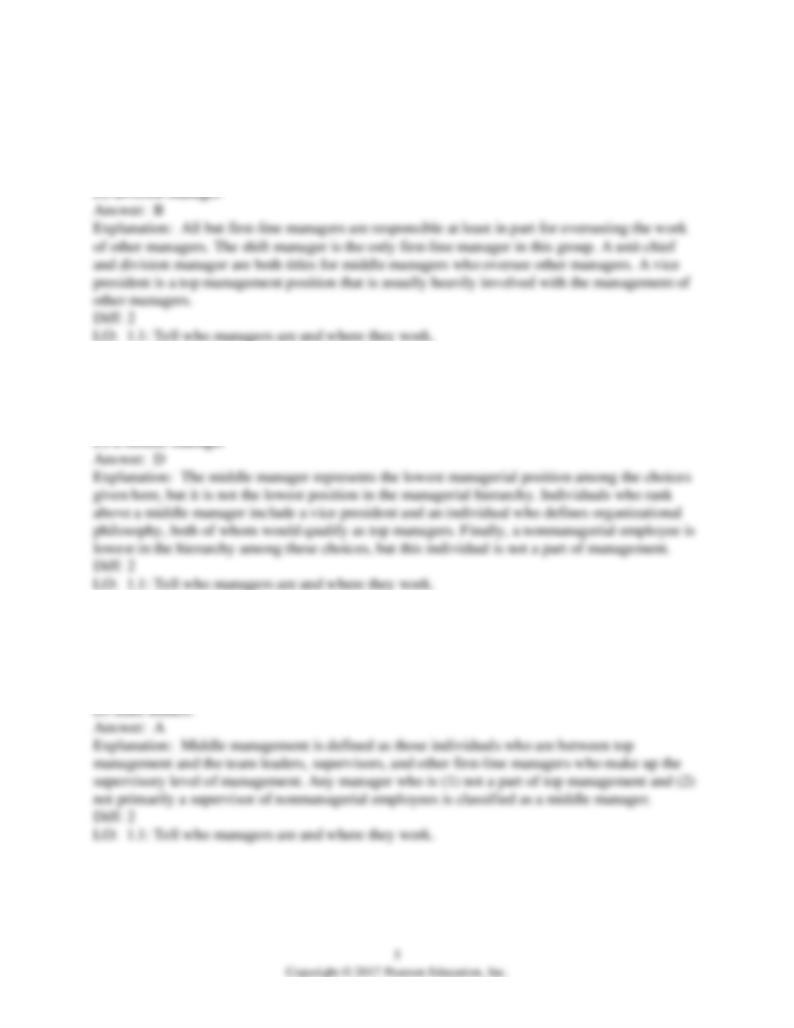
12) Which of the following identifies a manager who does NOT typically supervise other
managers?
A) unit chief
B) shift manager
C) vice president
13) Of the following, which is the lowest level of management?
A) a nonmanagerial employee
B) an individual involved in defining the organization's philosophy
C) a vice president
14) All levels of management between the supervisory level and the top level of the organization
are termed ________.
A) middle managers
B) first-line managers
C) supervisors

15) Which of the following levels of management is associated with positions such as executive
vice president, chief operating officer, chief executive officer, and chairperson of the board?
A) team leaders
B) middle managers
C) first-line managers
16) Brenda's high project completion rate indicates that she is ________.
A) an efficient manager
B) an effective manager
C) a good spokesperson
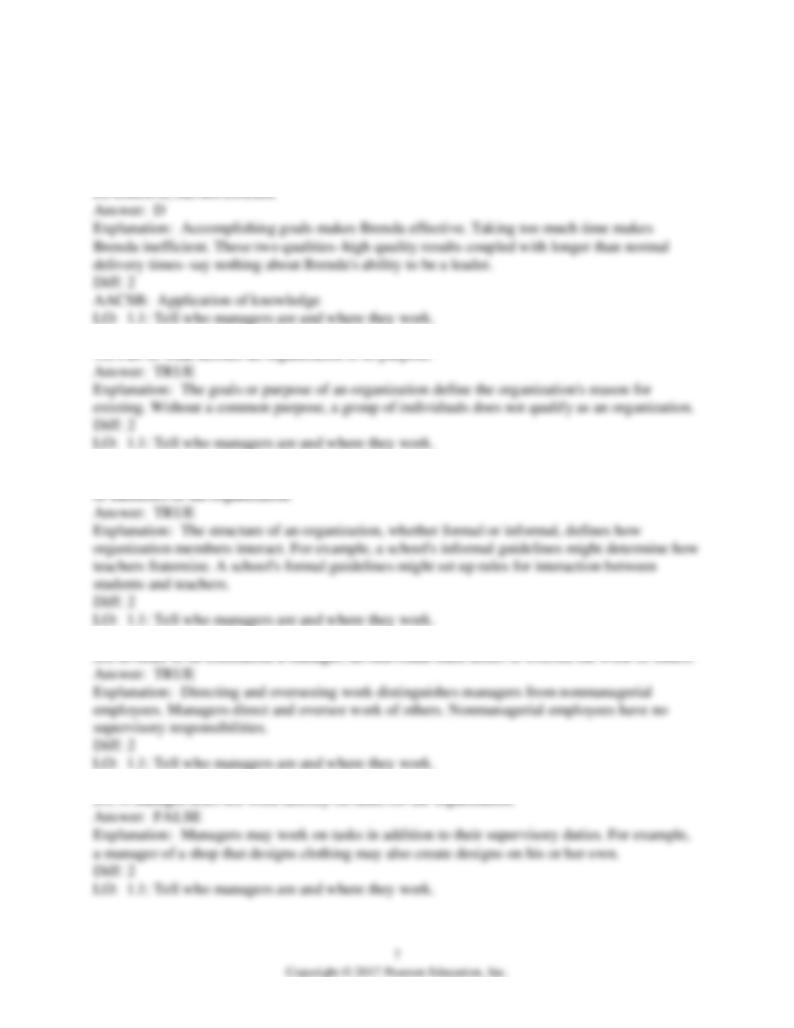
17) If Brenda accomplished her projects on time with high-quality results, but she took more
time than other managers in the process, you could say that as a manager she was ________.
A) efficient, but not effective
B) a leader, but not a top manager
C) project oriented, but not effective
19) All organizations have a structure that in some ways serves to define and limit the behavior
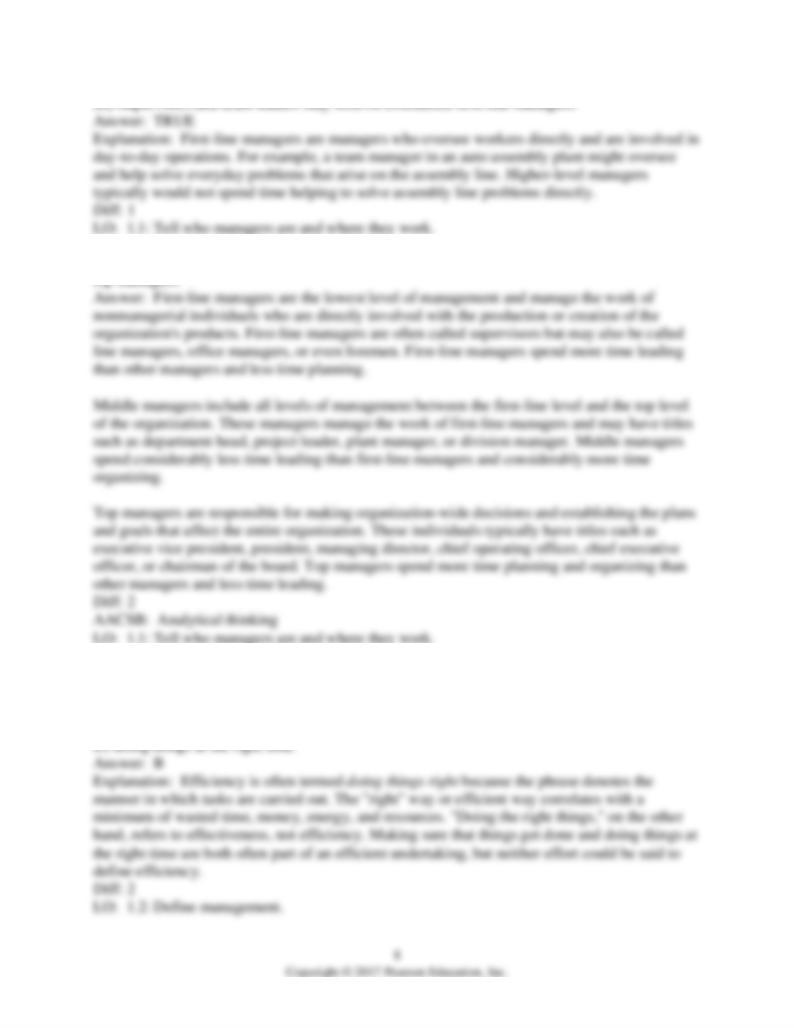
23) In a short essay, compare the tasks, priorities, and responsibilities of first-line, middle, and
24) Another term for efficiency is ________.
A) doing the right things
B) doing things right
C) making sure things get done
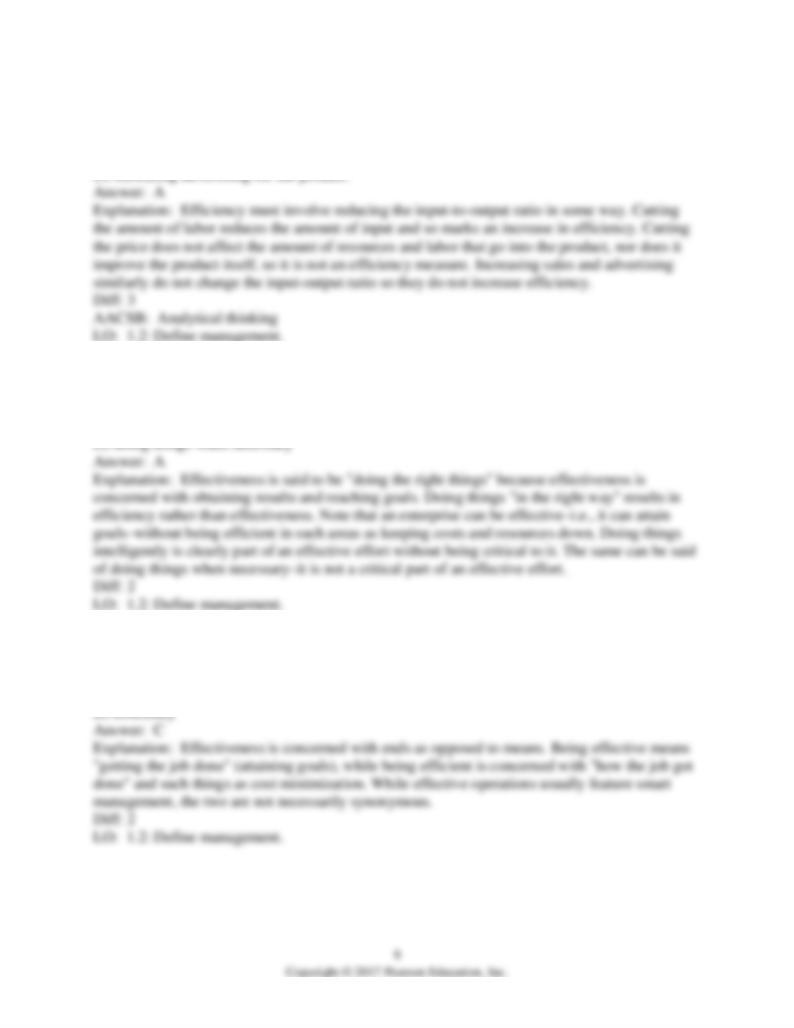
25) Which of the following might be an example of increased efficiency in manufacturing?
A) cutting the amount of labor required to make the product
B) cutting the price of the product
C) increasing sales of the product
26) Another term for effectiveness is ________.
A) doing the right things
B) doing things right
C) doing things intelligently
27) Effectiveness is synonymous with ________.
A) cost minimization
B) smart management
C) goal attainment

28) Efficiency refers to ________.
A) the relationship between inputs and outputs
B) the additive relationship between inputs and outputs
C) the inverse relationship between inputs and outputs
29) Good management strives for ________.
A) low efficiency and high effectiveness
B) high efficiency and low effectiveness
C) high efficiency and high effectiveness
30) A candy manufacturer would increase both efficiency and effectiveness by making
________.
A) better candy at the same cost
B) better candy at a lower cost
C) the same candy at a lower cost
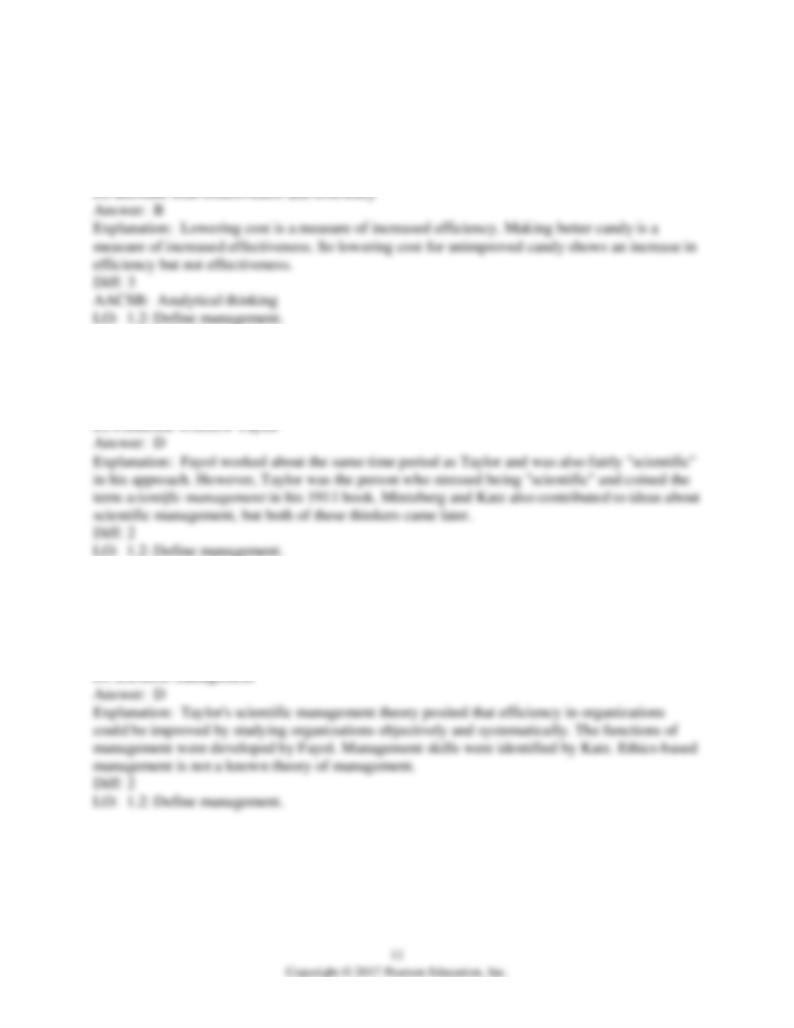
31) A candy manufacturer that made candy at a lower cost without improving the quality of the
candy could be said to ________.
A) increase effectiveness without increasing efficiency
B) increase efficiency without increasing effectiveness
C) increase both effectiveness and efficiency
32) The "father" of scientific management was ________.
A) Henri Fayol
B) Robert L. Katz
C) Henry Mintzberg
33) Taylor began to develop his theory of ________ after a result of viewing workers in steel
companies.
A) the functions of management
B) ethics-based management
C) management skills
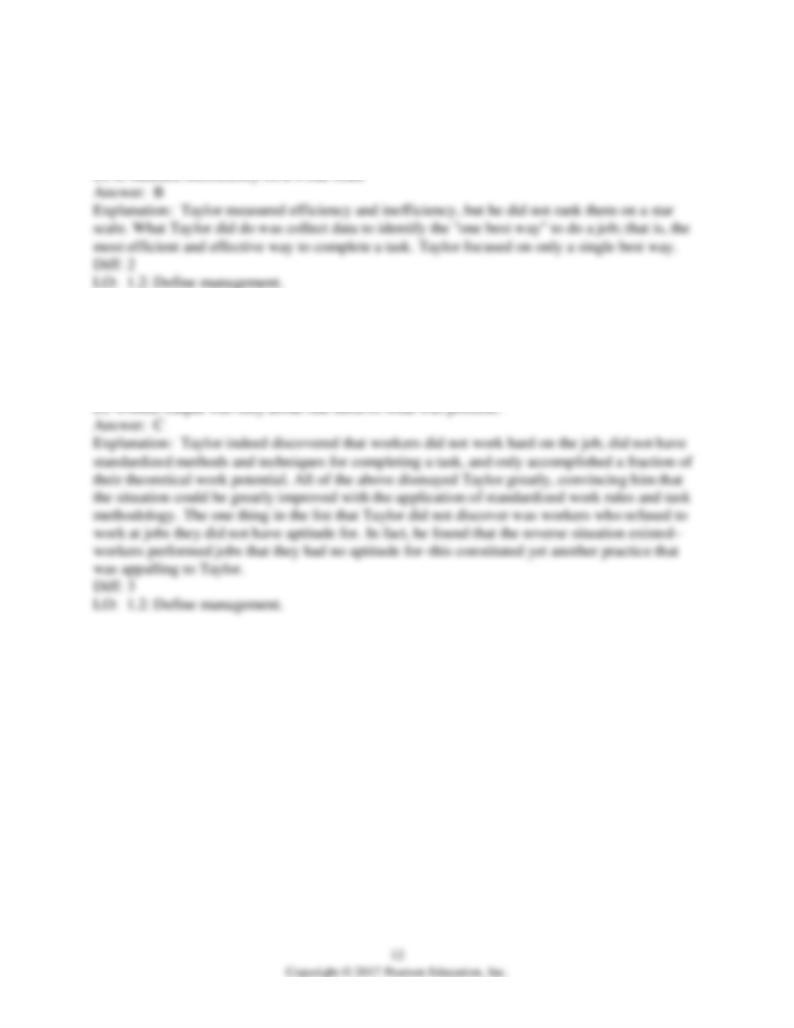
34) A major contribution that Taylor made to the study of management was ________.
A) to measure efficiency on a 4-star scale
B) to identify the one best way to get a job done
C) to identify the three best ways to get a job done
35) Which of the following did Taylor NOT find "appalling" in his study of workers in steel
companies?
A) Workers "took it easy" on the job.
B) Workers employed different techniques for the same job.
C) Workers would only attempt to perform a job if they were shown to have aptitude for it.
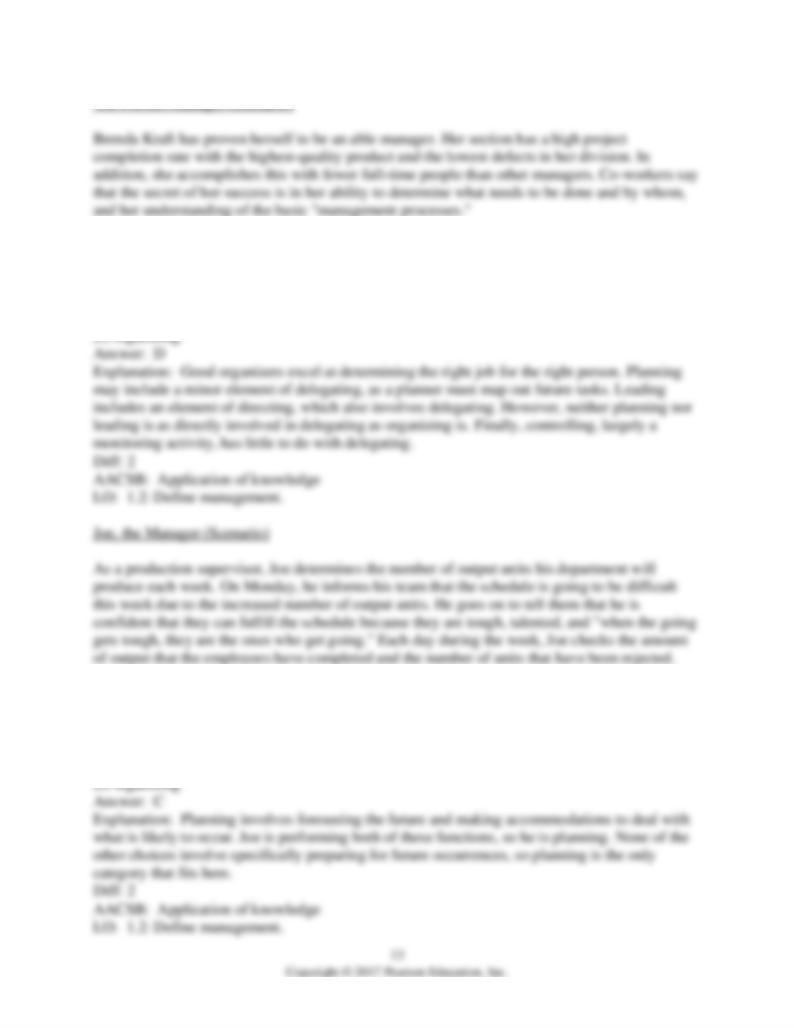
The Perfect Manager (Scenario)
36) Brenda's ability to determine what needs to be done and by whom is evidence that she excels
at which management function?
A) planning
B) controlling
C) leading
37) When Joe decides the number of output units his team will be able to produce this week,
which management process is he performing?
A) controlling
B) leading
C) planning

42) The four contemporary management processes are planning, organizing, leading, and
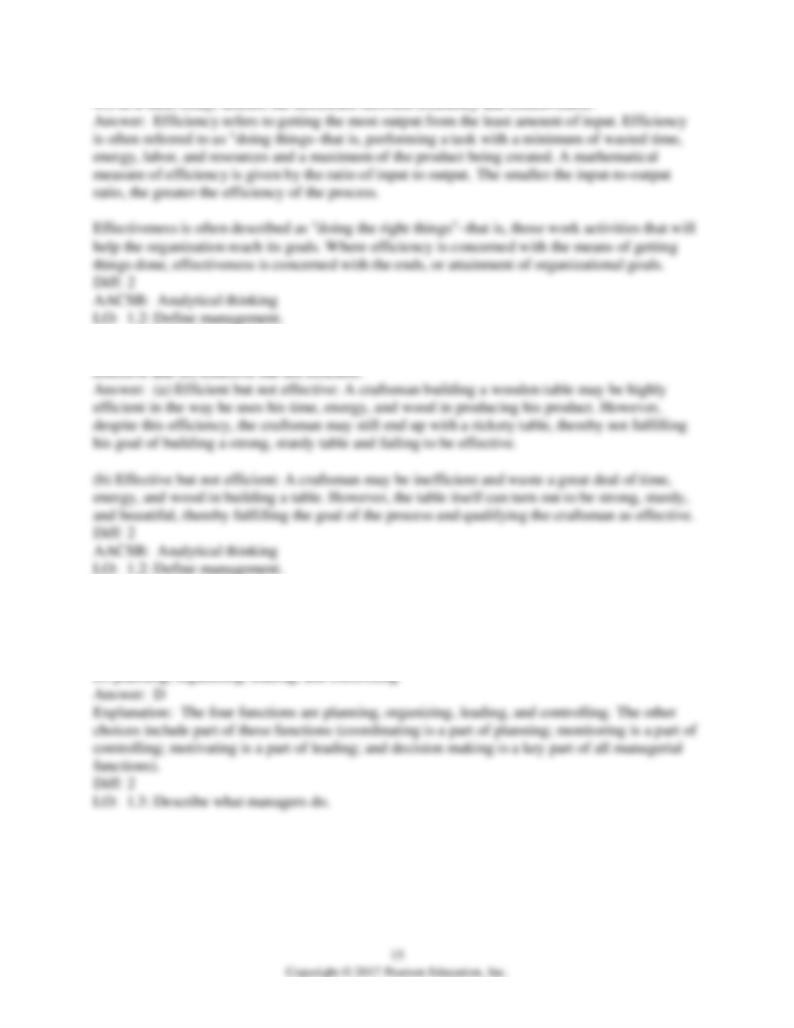
44) In a short essay, explain through examples how a process can be (a) efficient but not
45) Today, the basic management functions are considered to be ________.
A) planning, coordinating, leading, and monitoring
B) planning, organizing, leading, and motivating
C) commanding, organizing, leading, and decision making
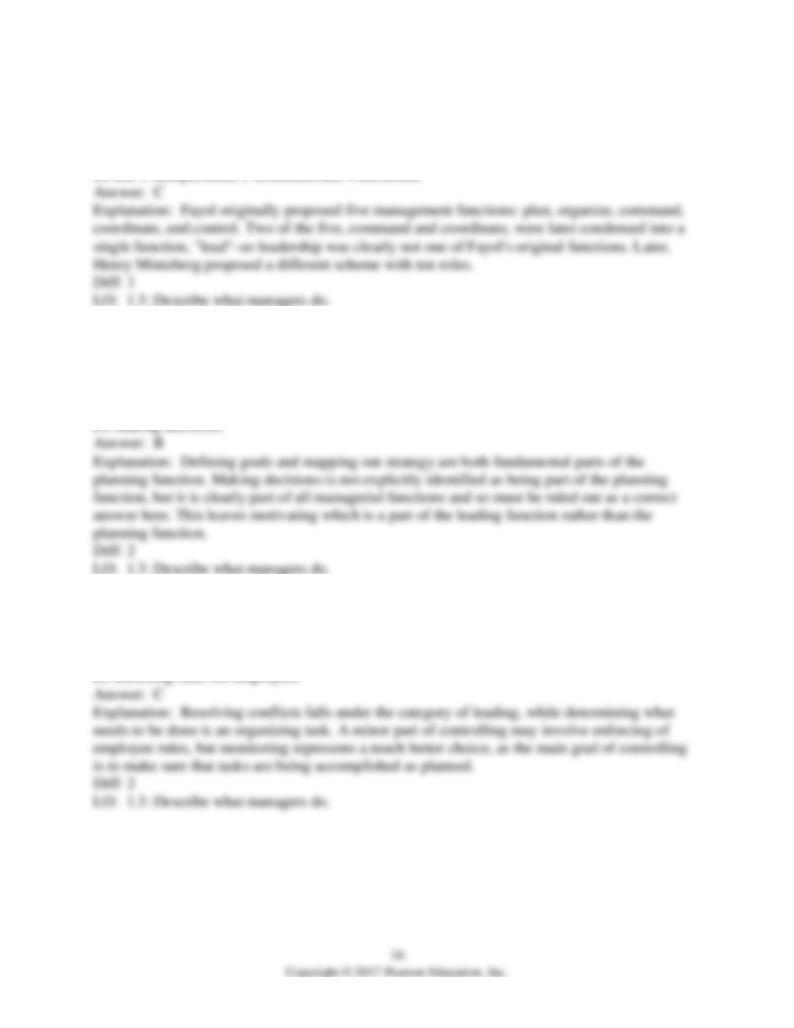
46) How many management functions were originally proposed by Henri Fayol?
A) three: plan, organize, lead
B) four: plan, organize, lead, control
C) five: plan, organize, command, coordinate, control
47) Which of the following is NOT considered to be a part of the planning function of a
manager?
A) defining goals
B) motivating
C) mapping out strategy
48) The controlling management function is largely a matter of ________.
A) resolving conflicts
B) determining what needs to be done
C) monitoring to see that tasks are accomplished
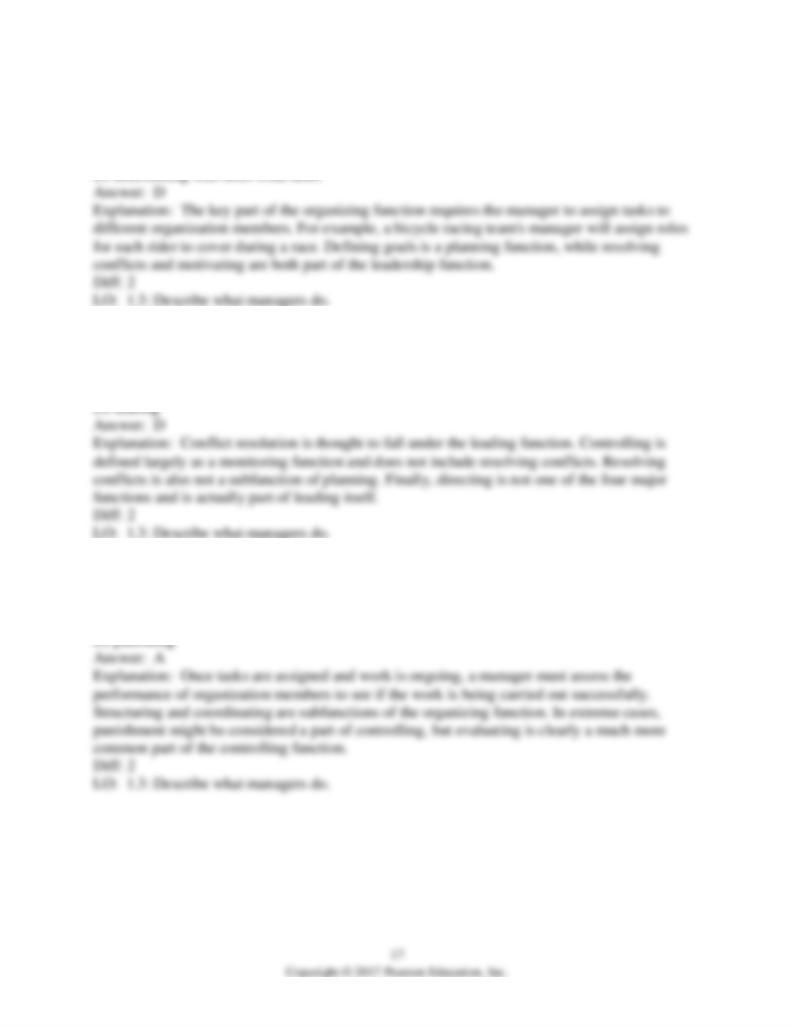
49) Organizing includes ________.
A) defining organizational goals
B) resolving conflicts
C) motivating organizational members
50) Resolving a conflict would be considered to fall under which managerial function?
A) controlling
B) planning
C) directing
51) An important part of the controlling function is ________.
A) evaluating
B) structuring
C) coordinating
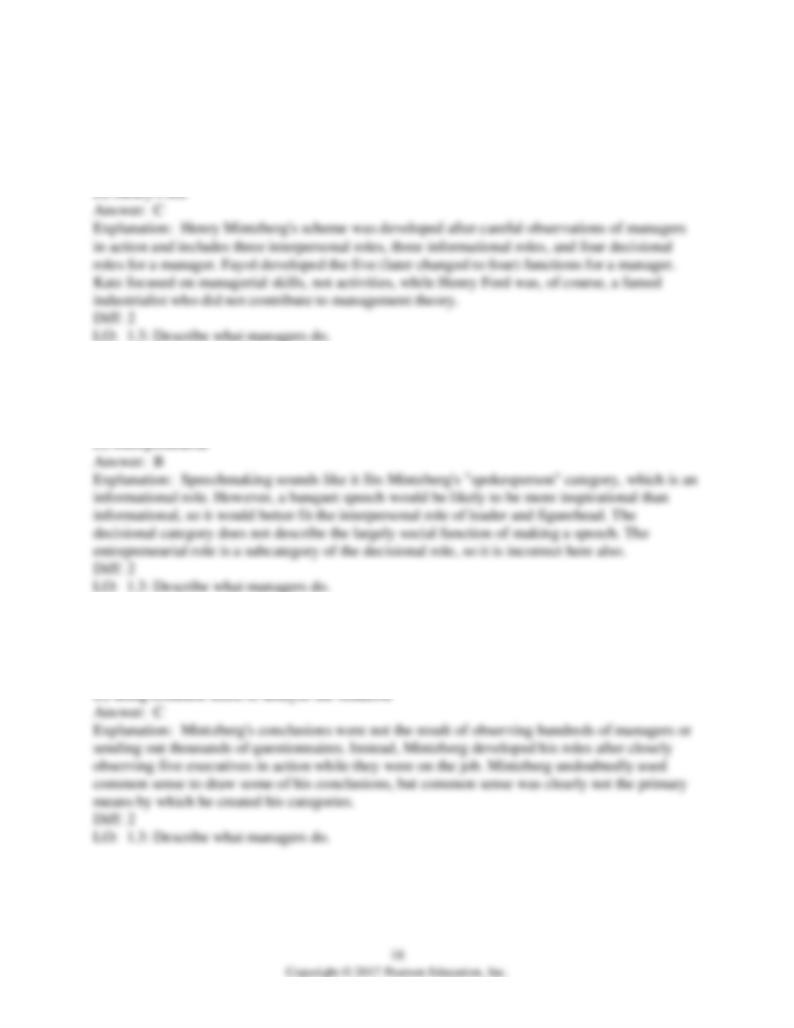
52) ________ developed a categorization scheme for defining what managers do, consisting of
10 different but highly interrelated roles.
A) Henri Fayol
B) Robert L. Katz
C) Henry Mintzberg
53) Giving a speech at an organization banquet would fall into which Mintzberg category?
A) informational
B) interpersonal
C) decisional
54) Mintzberg developed his ten managerial roles by ________.
A) sending out questionnaires to thousands of managers
B) observing hundreds of managers over several years
C) closely monitoring the work activities of five chief executives
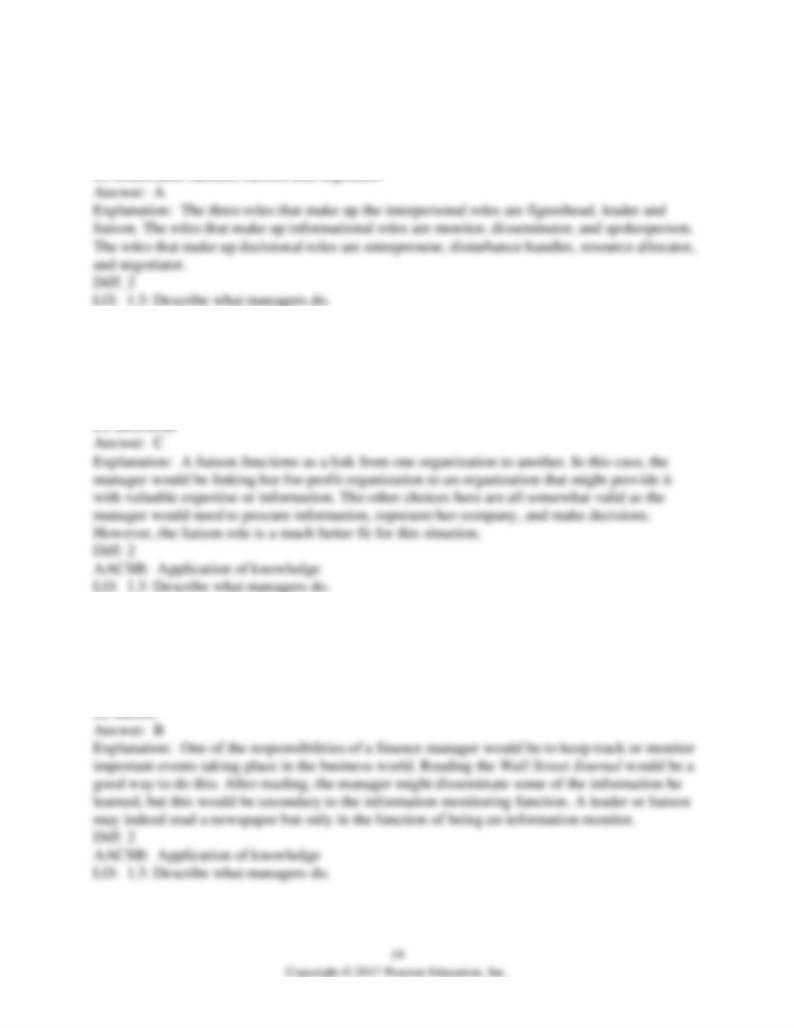
55) According to Mintzberg, which of the following fit into the category of interpersonal roles?
A) figurehead, leader, and liaison
B) negotiator, liaison, and figurehead
C) monitor, leader, and resource allocator
56) A pharmaceutical company manager attending a meeting of academic scientists would be
functioning in which role?
A) informational
B) figurehead
C) liaison
57) A finance manager who reads the Wall Street Journal on a regular basis would be
performing which role?
A) leader
B) monitor
C) disseminator
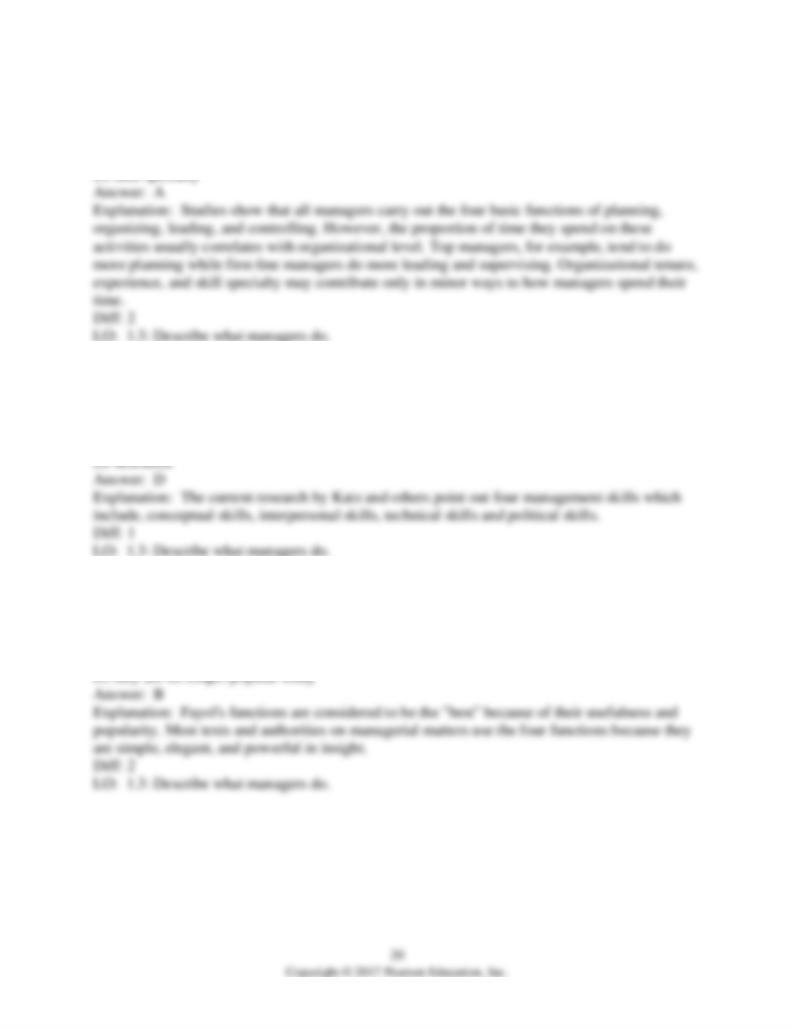
58) The emphasis that managers give to various activities is generally based on their ________.
A) organizational level
B) tenure with the organization
C) experience in their field
59) The current research on managerial skill points to four general management skills. Wh ich of
the following is NOT one of the four skills?
A) Political
B) Interpersonal
C) Conceptual
60) The four managerial functions first described by Fayol are considered the "best" because
________.
A) they were devised a long time ago
B) most sources still use them
C) they date back to ancient Greece and Rome
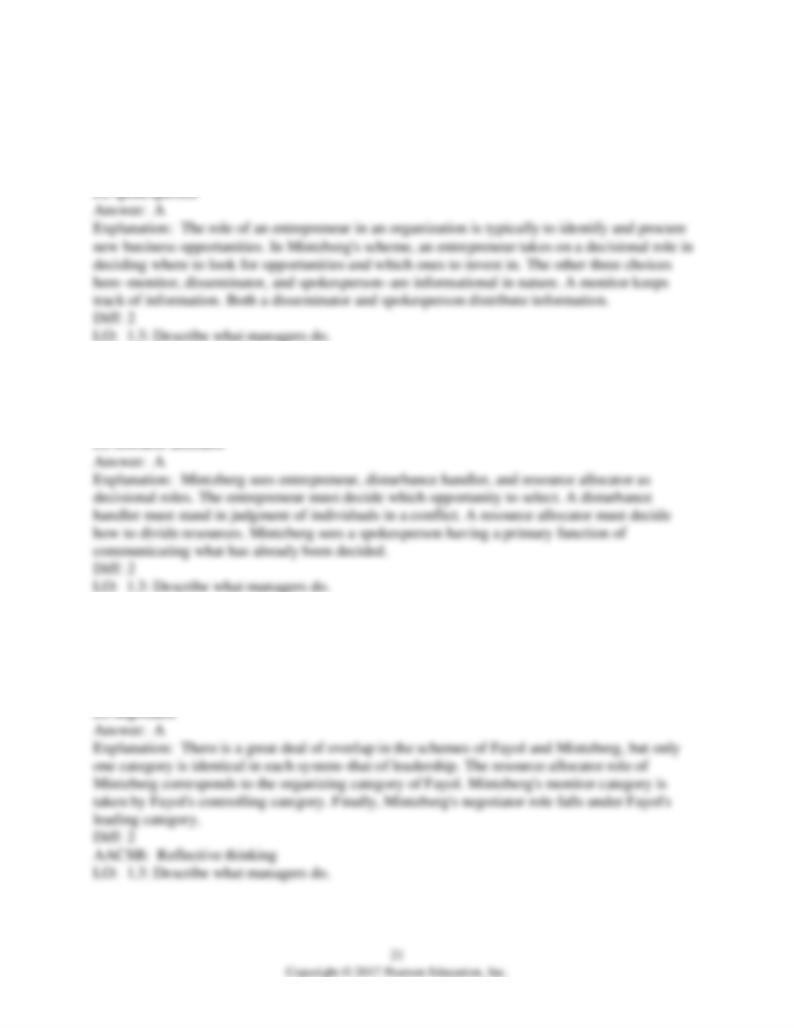
61) All of the following are examples of informational roles according to Mintzberg EXCEPT
________.
A) entrepreneur
B) monitor
C) disseminator
62) Which of the following is NOT an example of a decisional role according to Mintzberg?
A) spokesperson
B) entrepreneur
C) disturbance handler
63) One managerial function that is identical in both Fayol's and Mintzberg's systems is
________.
A) leader
B) resource allocator
C) monitor
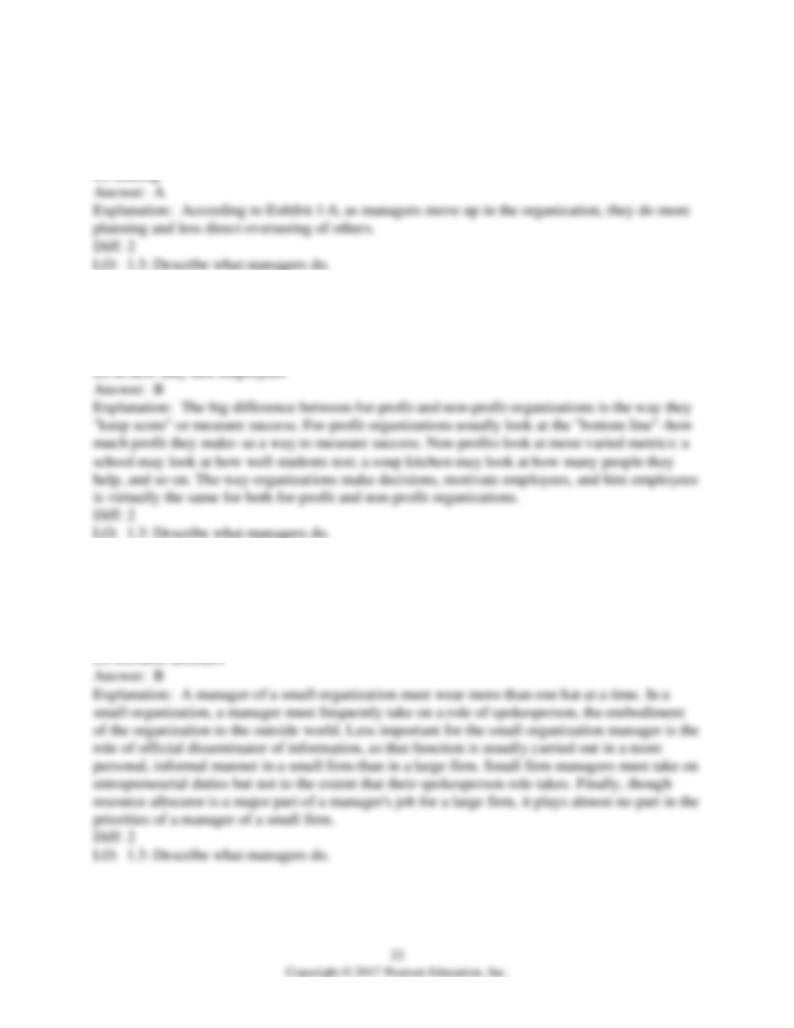
64) The managerial role that changes the most between middle and top managers is ________.
A) planning
B) organizing
C) controlling
65) Non-profit organizations are different from for-profit organizations primarily ________.
A) in the way make decisions
B) in the way they measure success
C) in the way they motivate employees
66) The role of ________ is more important for managers of small organizations than for
managers working in large corporations.
A) disseminator
B) spokesperson
C) entrepreneur
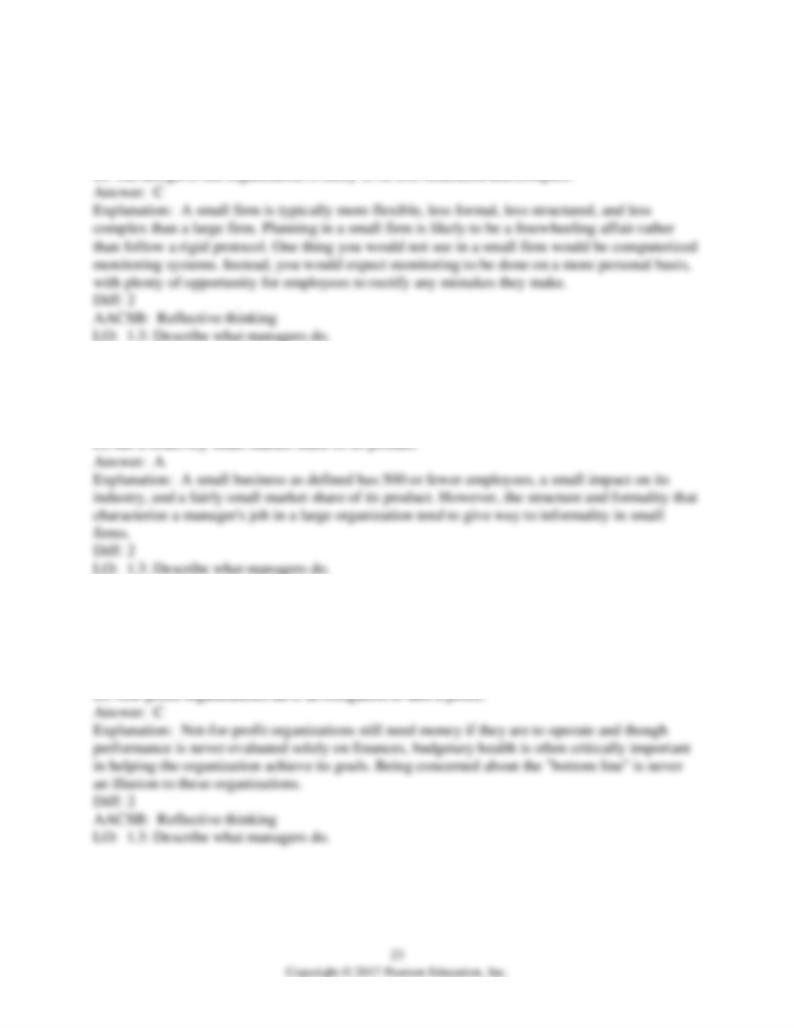
67) In a small organization, which of the following is NOT likely to be true?
A) Planning is not likely to be an orchestrated ritual.
B) Relationships are more likely to be informal.
C) Workers are likely to be observed by computerized monitoring systems.
68) Which of the following is NOT a characteristic of a small business?
A) has more formal managers than a large business
B) has about 200 employees
C) is not a "player" with impact within its industry
69) Why might a manager for a non-profit organization seem as concerned with his or her
organization's financial well-being as a for-profit manager?
A) Non-profit managers are evaluated on financial performance only.
B) Non-profit managers try to give the illusion that they care about the "bottom line."
C) Not-for-profit organizations need to make money to continue operating.
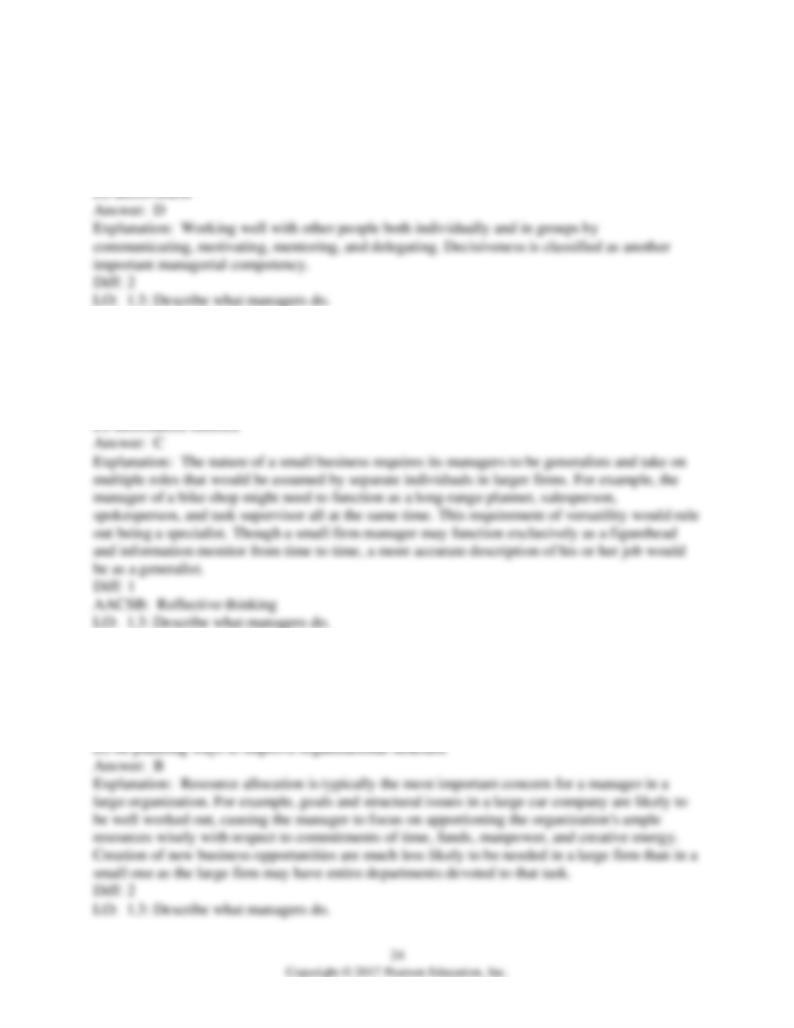
70) Which of the following is NOT considered an interpersonal skill for a manager as suggested
by Katz?
A) communicating
B) mentoring
C) delegating
71) Compared to the manager of a large organization, a small business manager is more likely to
be a(n) ________.
A) specialist
B) figurehead
C) generalist
72) Unlike the manager of a small business, the most important concerns of a manager in a large
organization are focused ________.
A) externally, particularly on entrepreneurial tasks
B) internally, particularly on the allocation of resources
C) on setting goals
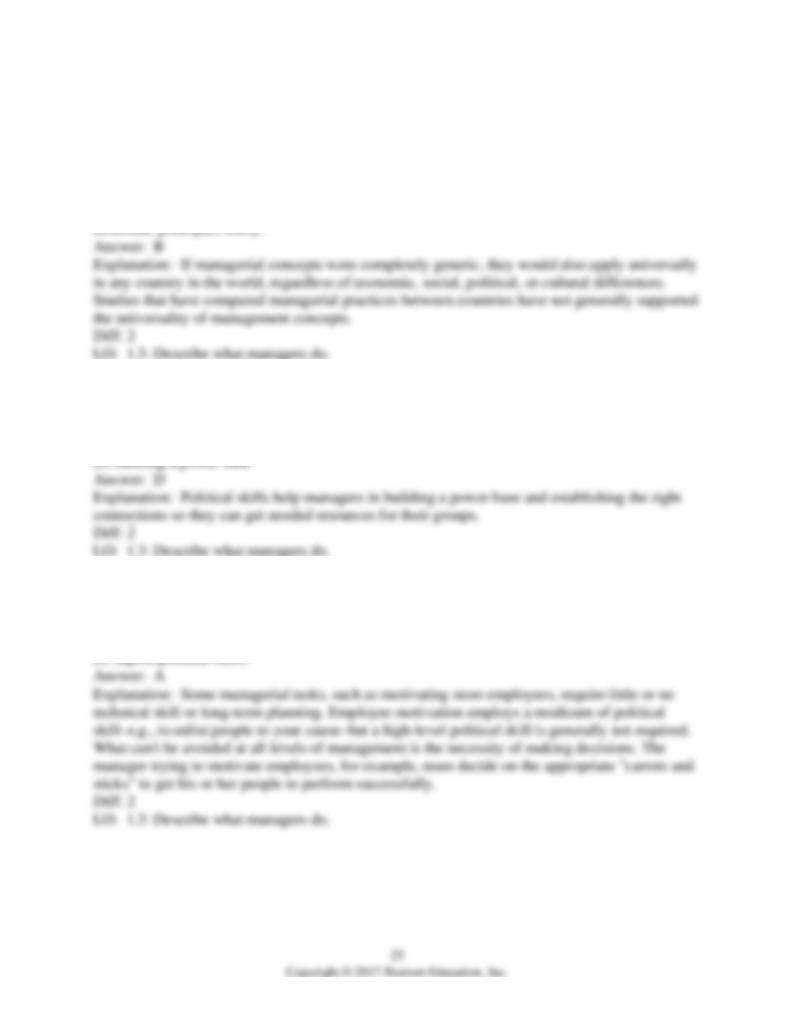
73) Which of the following statements regarding management and national culture is the most
correct?
A) The basic principles of management are universal.
B) Research shows that managerial practices across all countries are not consistent.
C) There are major differences in the way that most English speaking countries view
management.
D) The route of the differences between how countries practice management is based on their
74) Which of the following would political skills be most likely to help a manager accomplish?
A) increasing communication
B) mentoring
C) defining goals
75) Almost all managerial tasks involve ________.
A) decision making
B) technical skills
C) long-term planning
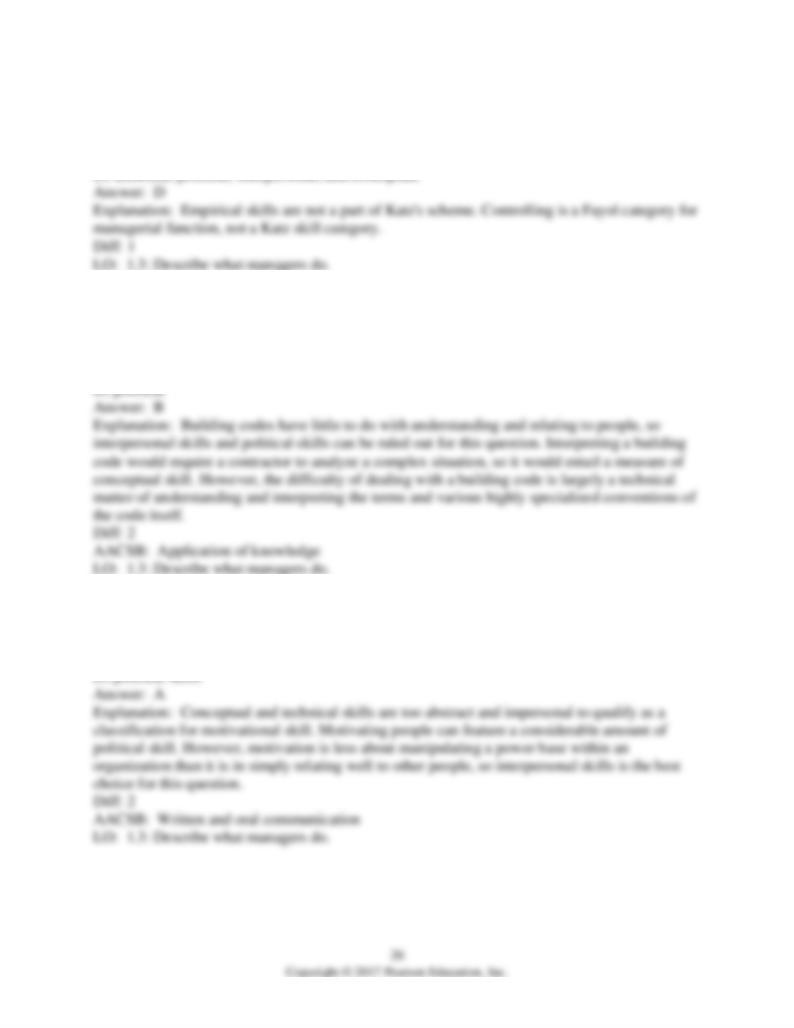
76) According to Katz, the four critical managerial skills can be classified as ________.
A) technical, political, conceptual, and empirical
B) interpersonal, political, empirical, and technical
C) technical, interpersonal, political, and controlling
77) Understanding building codes would be considered a(n) ________ skill for a building
contractor.
A) interpersonal
B) technical
C) conceptual
78) Under which category would you classify skill in motivating subordinates?
A) interpersonal skills
B) conceptual skills
C) technical skills
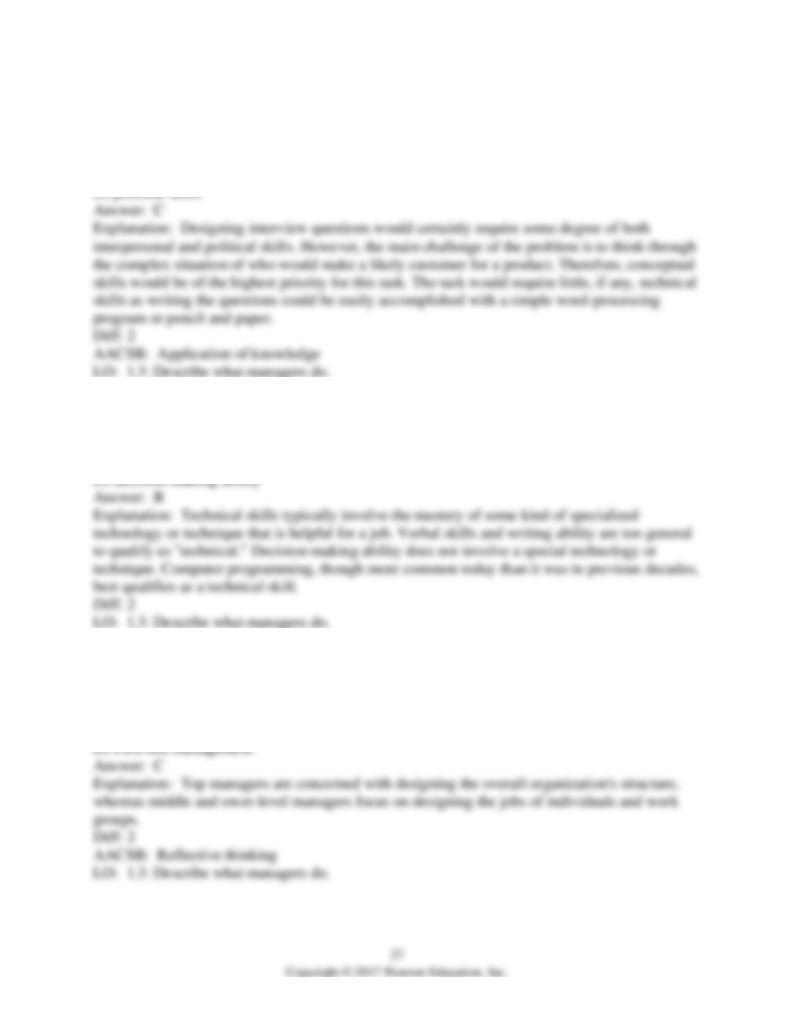
79) Designing a series of interview questions to provide information about possible customers
for a company would primarily require ________.
A) technical skills
B) interpersonal skills
C) conceptual skills
80) Technical skills might include ________.
A) excellent verbal skills
B) proficiency in computer programming
C) exceptional writing ability
81) Which level of management would be more concerned with designing the overall structure of
an organization?
A) Middle management
B) Supervisory management
C) Top management
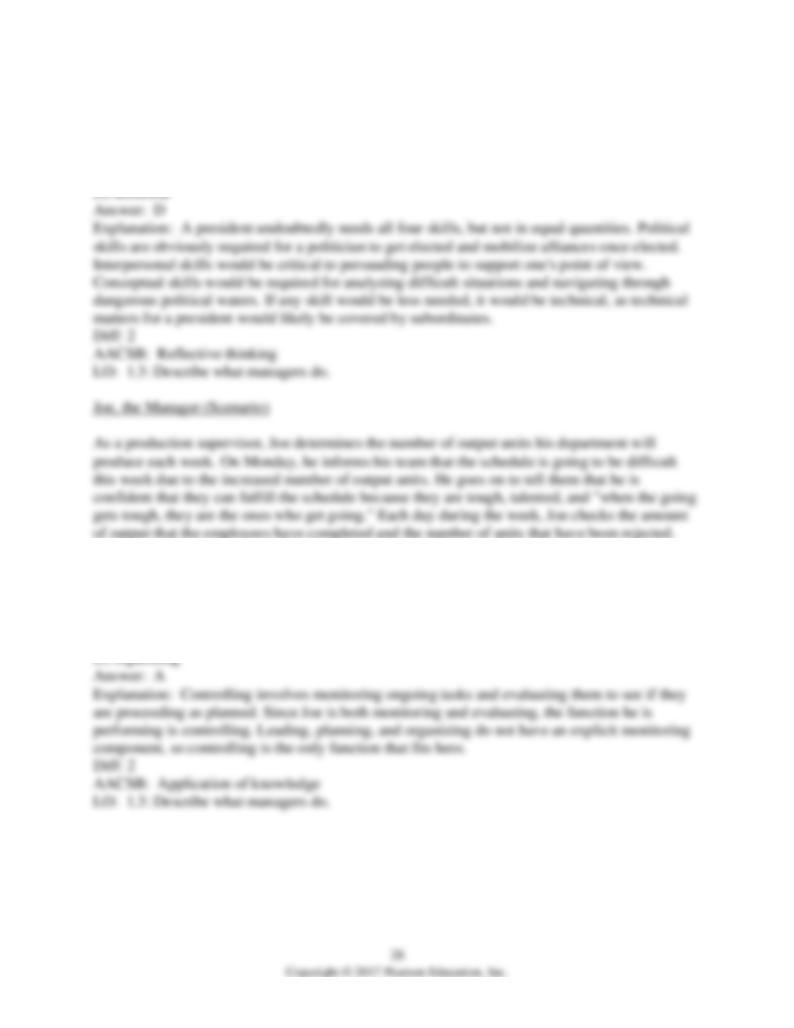
82) Which set of skills would you expect the President of the United States to be least in need
of?
A) interpersonal
B) political
C) conceptual
83) When Joe checks the amount of output units that the team has completed and the number of
units that have been rejected, he is performing which management process?
A) controlling
B) leading
C) planning
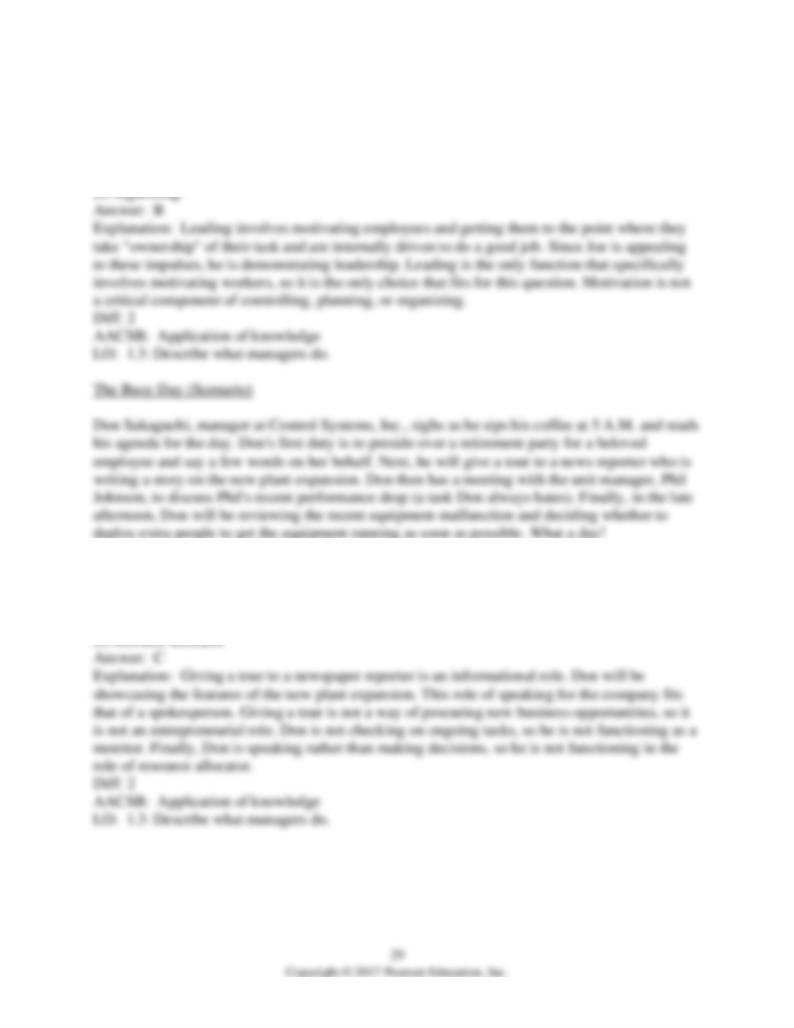
84) When Joe tells the employees that he is sure they can fulfill the schedule because they are the
ones "who get going when the going gets tough," he is performing which management process?
A) controlling
B) leading
C) planning
85) What role will Don be performing when he gives the plant tour to the newspaper reporter?
A) monitor
B) entrepreneur
C) spokesperson
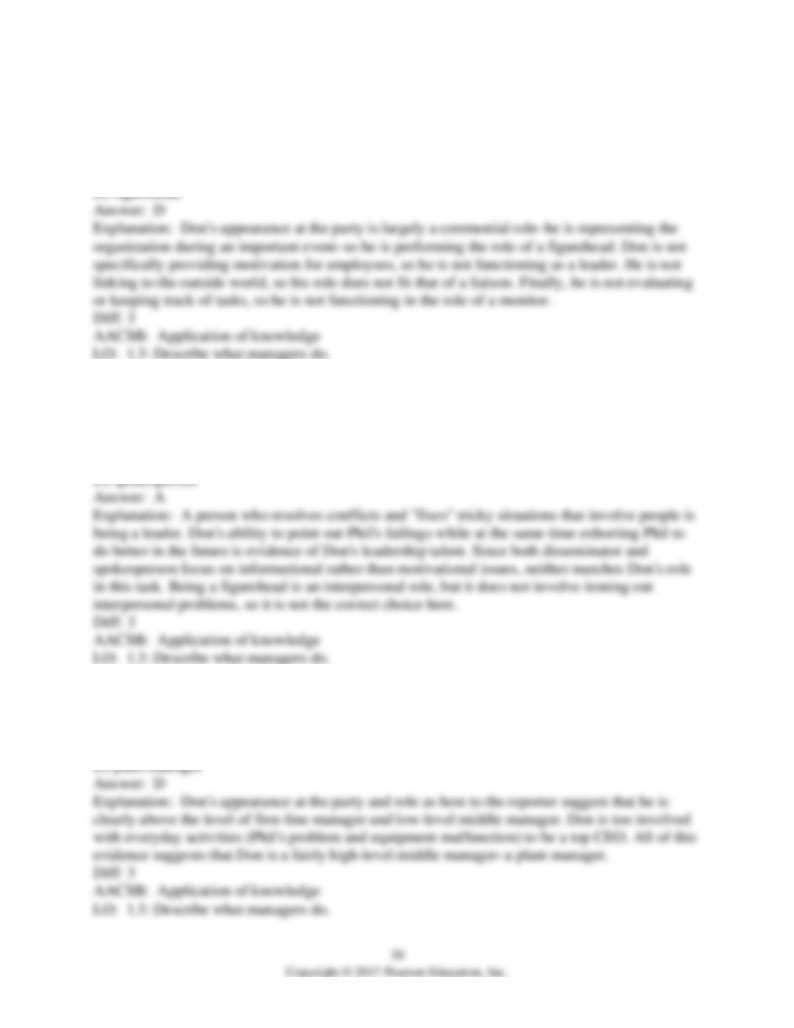
86) When Don attends the retirement party, he will be operating in which of the management
roles?
A) leader
B) liaison
C) monitor
87) When Don meets with Phil to discuss Phil's output decline, in which management role will
Don be operating?
A) leader
B) figurehead
C) disseminator
88) What kind of a manager is Don likely to be?
A) first-line manager
B) CEO of a major corporation
C) low-level middle manager
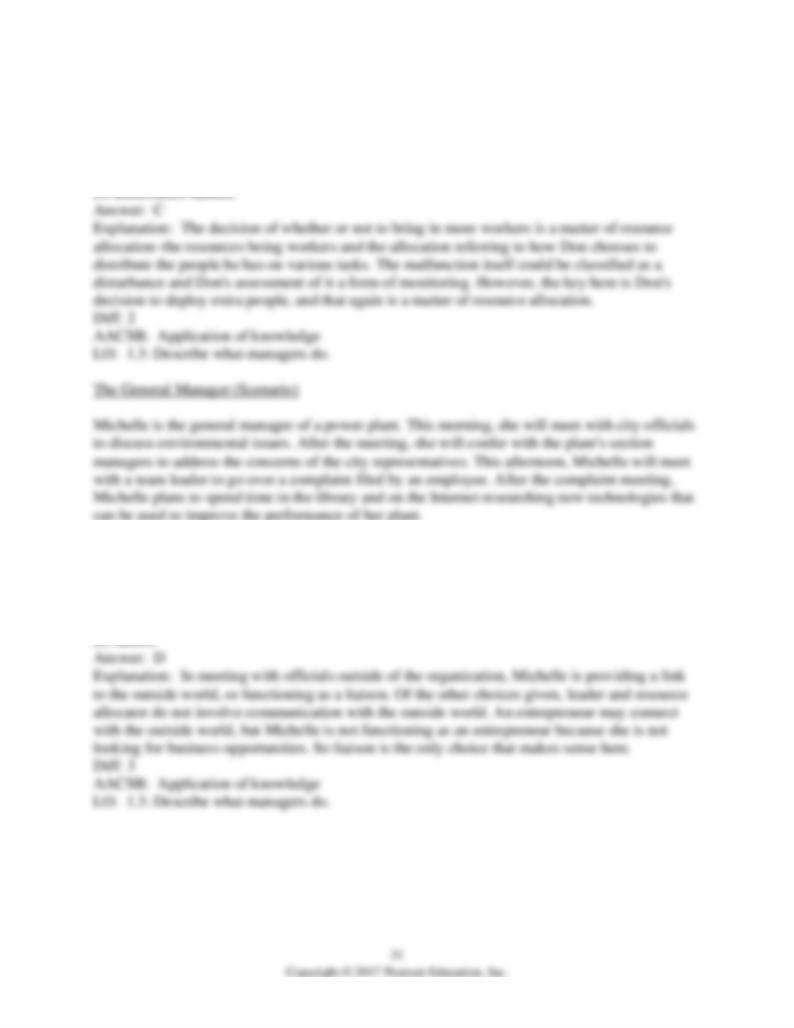
89) When Don reviews the equipment malfunction, what management role will he play in
deciding whether to bring in extra people?
A) monitor
B) disseminator
C) resource allocator
90) When Michelle learns from city officials about how her plant's operations may be affecting
the environment, she is performing which management role?
A) leader
B) resource allocator
C) entrepreneur
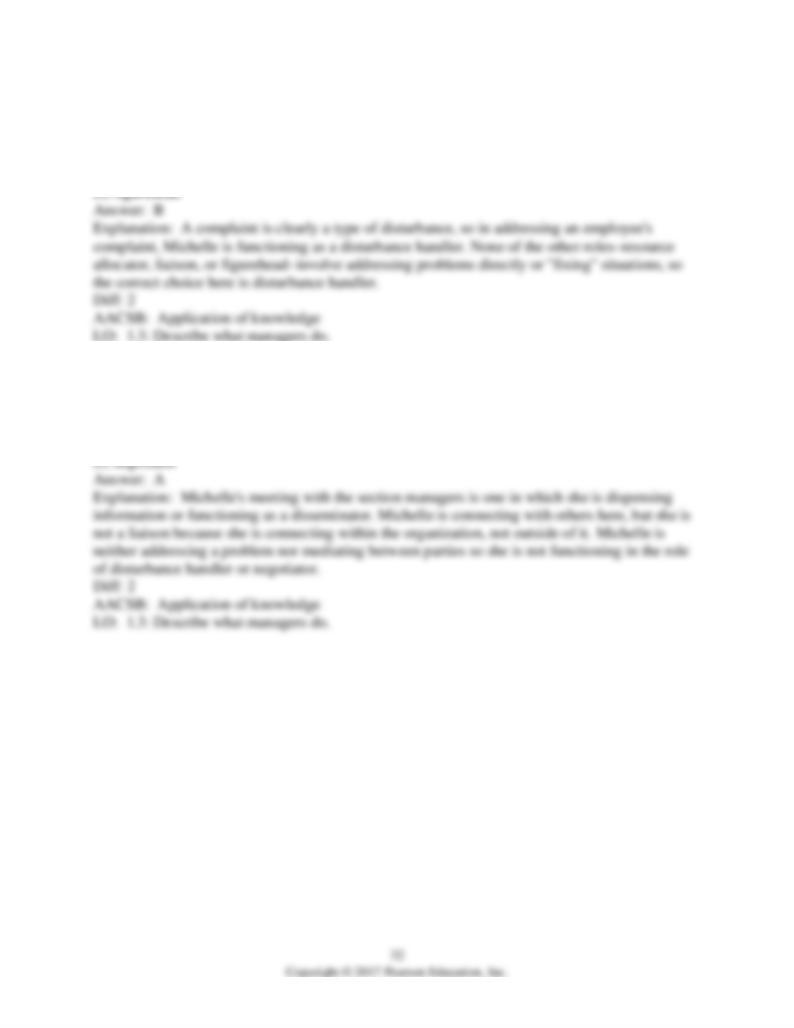
91) When Michelle addresses a complaint filed by an employee, she is performing which
management role?
A) resource allocator
B) disturbance handler
C) liaison
92) When Michelle meets with the section managers to brief them on the concerns of the city
officials, which management role is she performing?
A) disseminator
B) liaison
C) disturbance handler
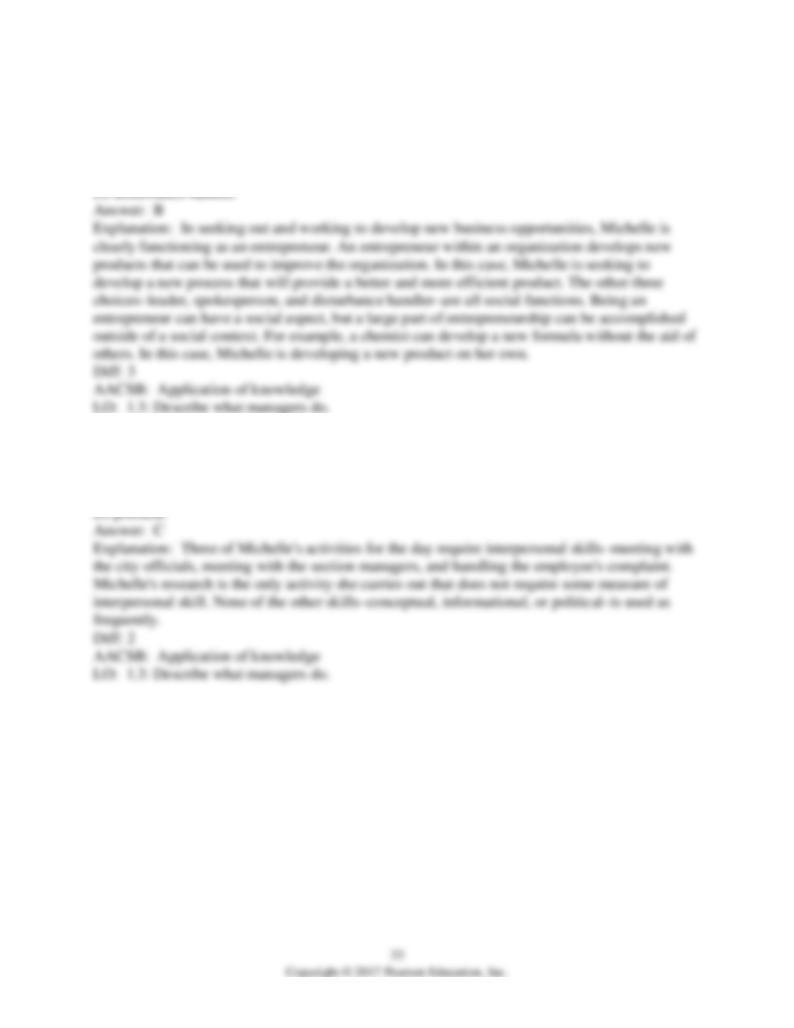
93) When Michelle spends time searching for new technologies for her plant, she is performing
which management role?
A) leader
B) entrepreneur
C) spokesperson
94) Which type of management skill does Michelle use most during the day?
A) conceptual
B) informational
C) interpersonal
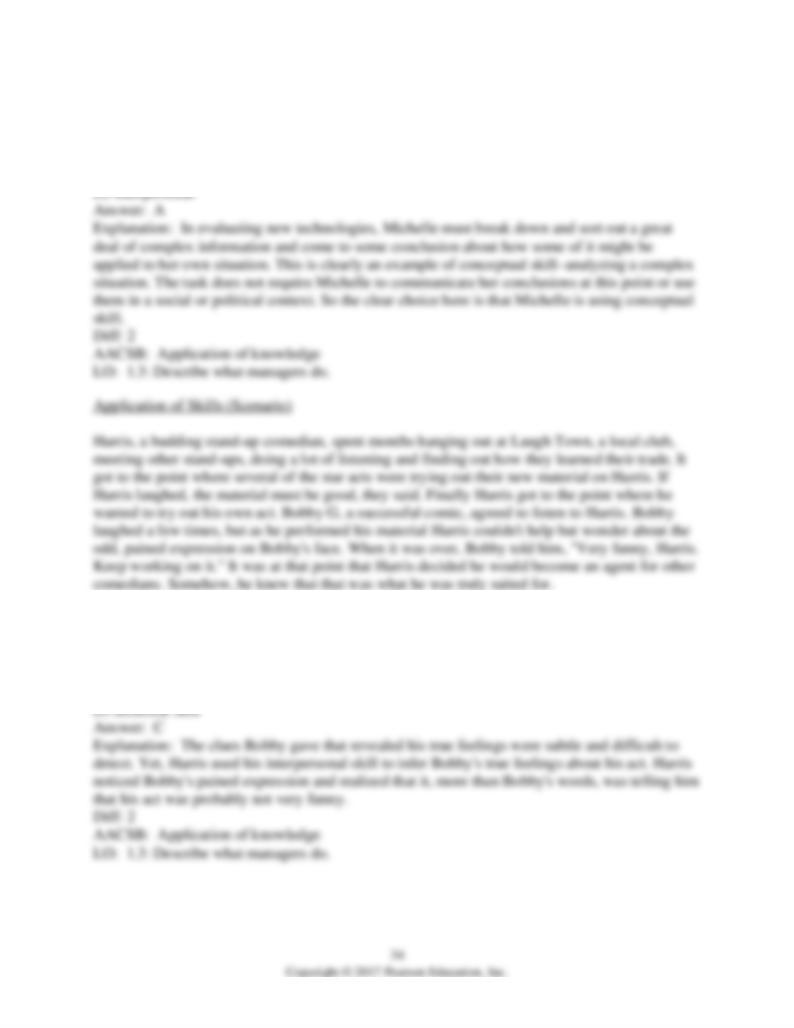
95) Michelle's evaluation of new technologies that can be used in the production processes of her
plant is an example of which type of management skill?
A) conceptual
B) communication
C) political
96) Recognizing that the pained expression on Bobby G's face had more meaning than Bobby's
encouraging words is an example of Harris using which skill?
A) conceptual skill
B) political skill
C) interpersonal skill
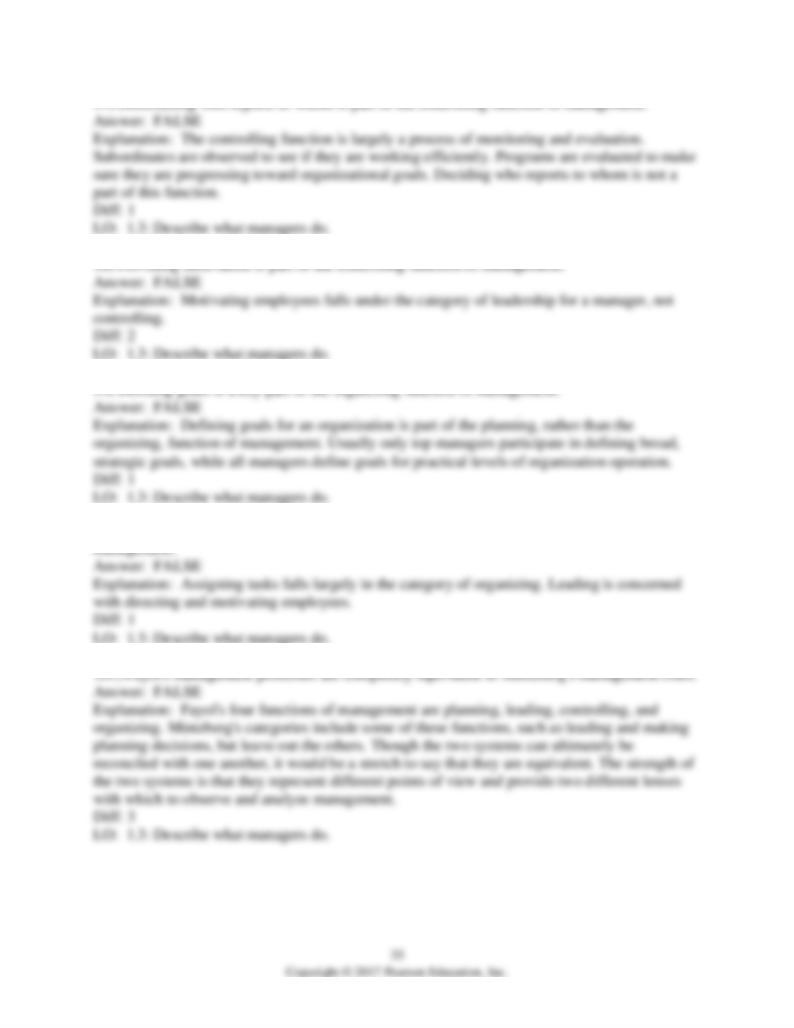
100) Deciding who will be assigned to which job is a part of the leading function of
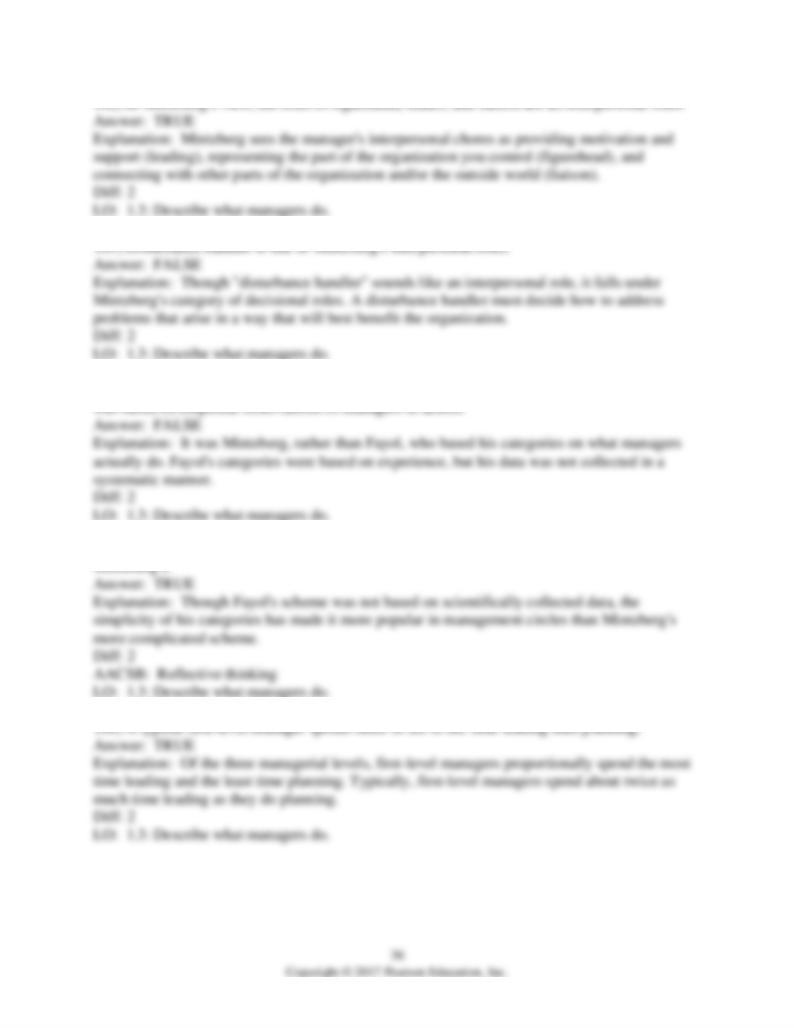
104) A key difference between Fayol's and Mintzberg's view of management is that Fayol's view
105) Most people who study management think that Fayol's categories are more useful than
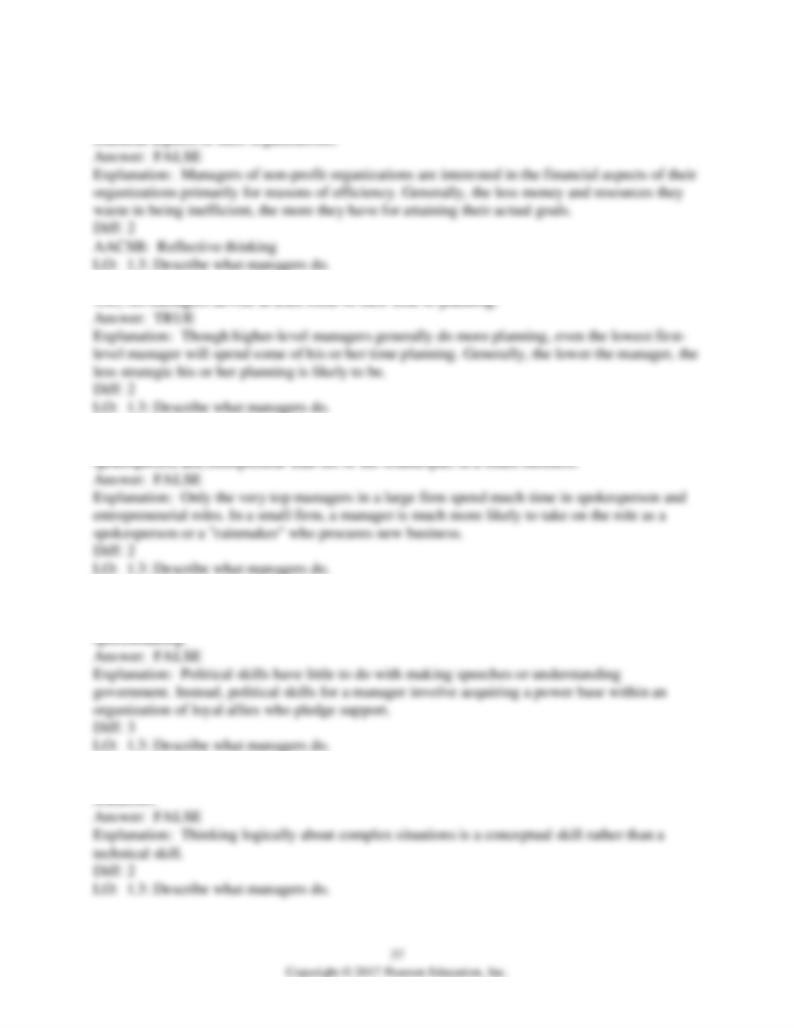
107) Because profit, or the "bottom line," is not the measure of success for not-for-profit
organizations, managers of charitable organizations do not have to concern themselves with the
109) A manager in a large business generally will spend more of his or her time as a
110) The political skills of a manager consist mainly of the ability to understand the workings of
government and to present information effectively to others in the form of political
111) Technical skills involve a manager's ability to think logically and effectively about complex
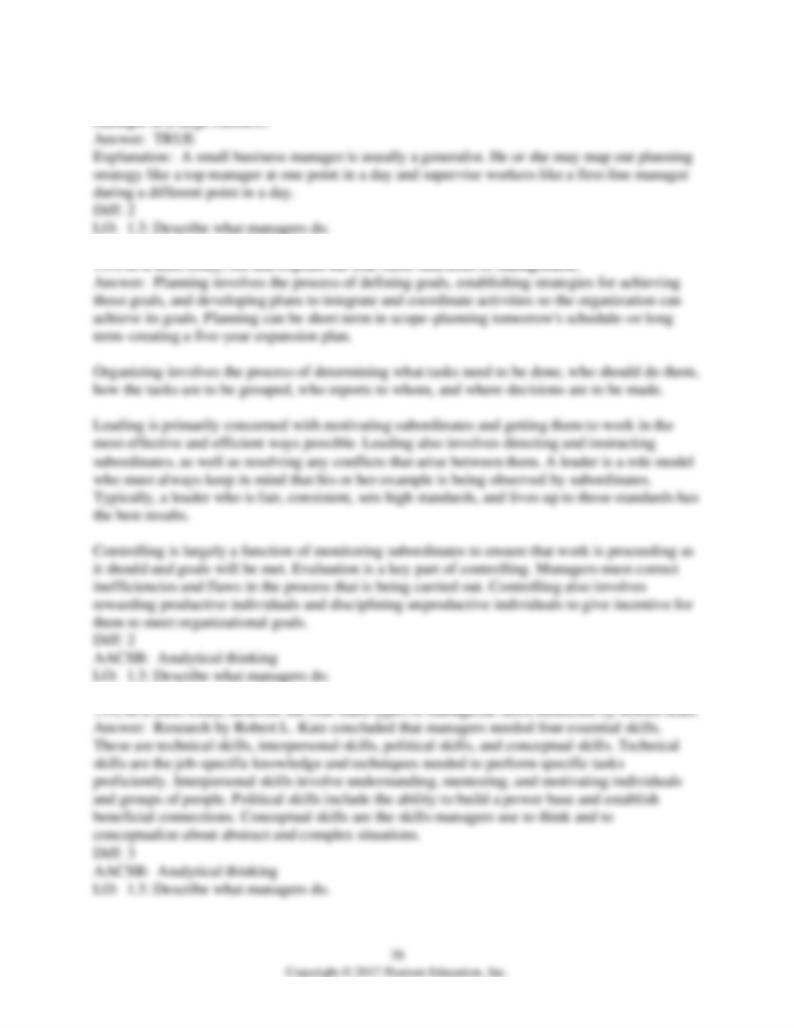
112) A small business manager in many ways combines the roles of top manager and first-line
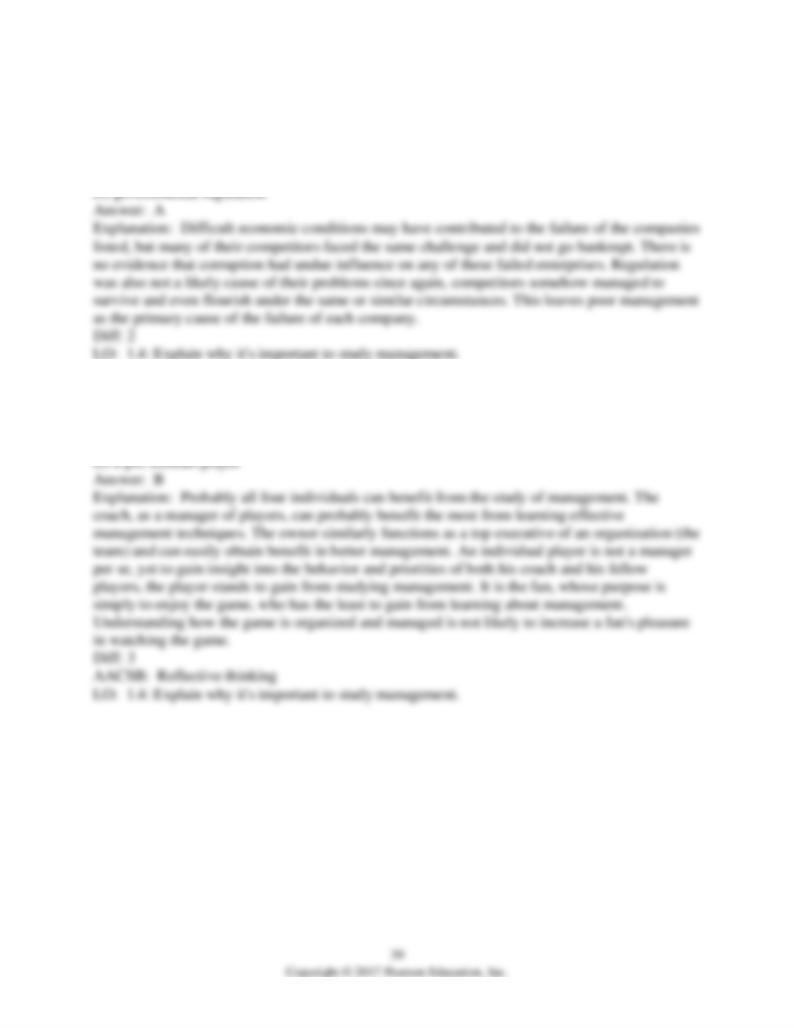
115) What was the primary cause of demise for such companies as Enron, Dave & Barry's, and
Circuit City?
A) poor management
B) difficult economic conditions
C) corruption
116) Who stands to benefit least from studying management?
A) a pro football coach
B) a pro football fan
C) a pro football owner

117) We all have a vested interest in understanding the way organizations are managed because
________.
A) we all stand to gain financially from organizational profits
B) we interact with organizations every day of our lives
C) we all depend on organizations for employment
118) Even people who have no plans to be managers can benefit from studying management
because ________.
A) they are likely to be managed in their work career
B) everyone ends up managing
C) they need to be able to outsmart their managers
D) management helps people control their emotions
119) Which of the following is the mark of a well-managed company?
A) It can build a customer base quickly.
B) It can find ways to prosper even in economically challenging times.
C) It doesn't need to worry about customer loyalty.
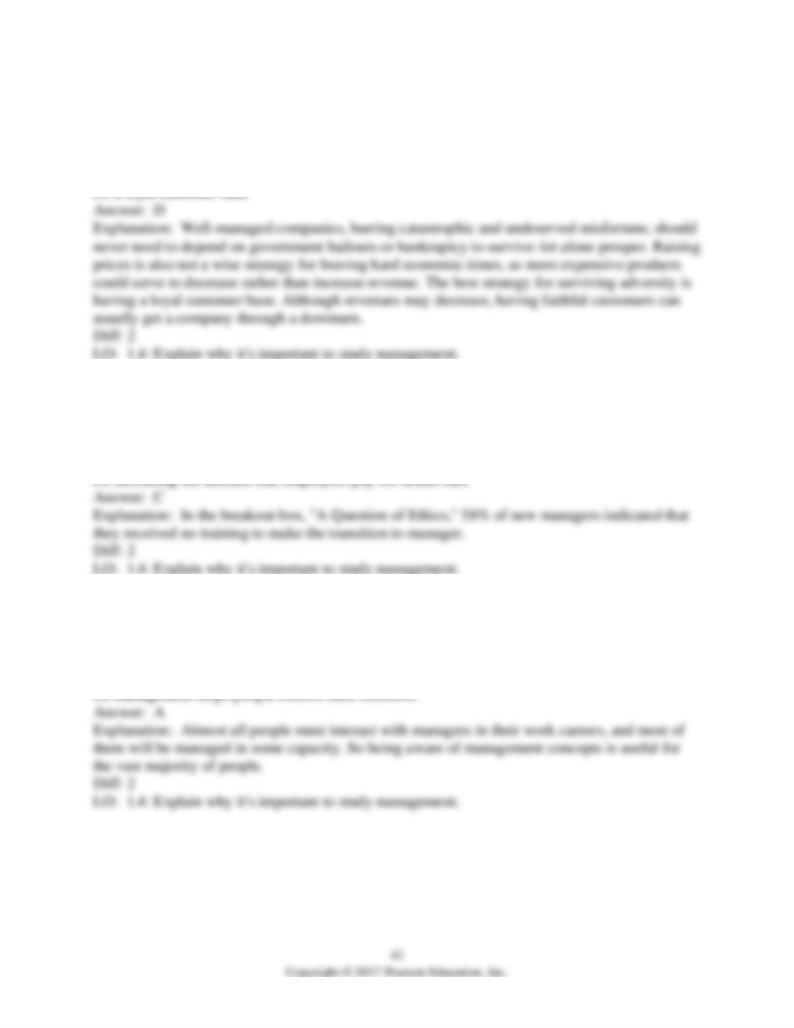
120) Companies that are well managed can prosper during difficult economic times by
depending on ________.
A) government bailouts
B) filing for bankruptcy
C) raising prices
121) Which of the following is a difficult ethical challenge to new managers in today's business
climate?
A) not being able to hire new employees
B) having to fire employees who are not productive
C) not receiving training in the transition to management
122) Even people who have no plans to be managers can benefit from studying management
because ________.
A) they are likely to be managed in their work career
B) everyone ends up managing
C) they need to be able to outsmart their managers
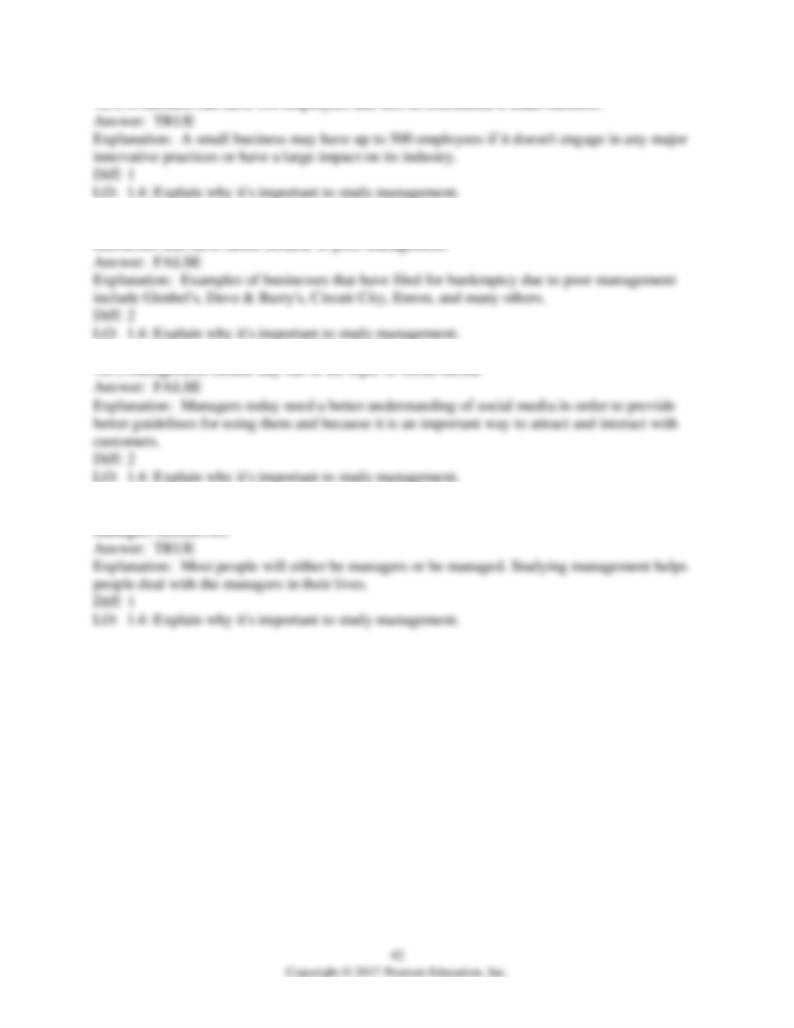
124) Management has an impact on all businesses, but there are almost no examples of
126) Studying management can be extremely useful even for those who don't plan to be

128) In a short essay, explain why customer satisfaction is becoming increasingly important in
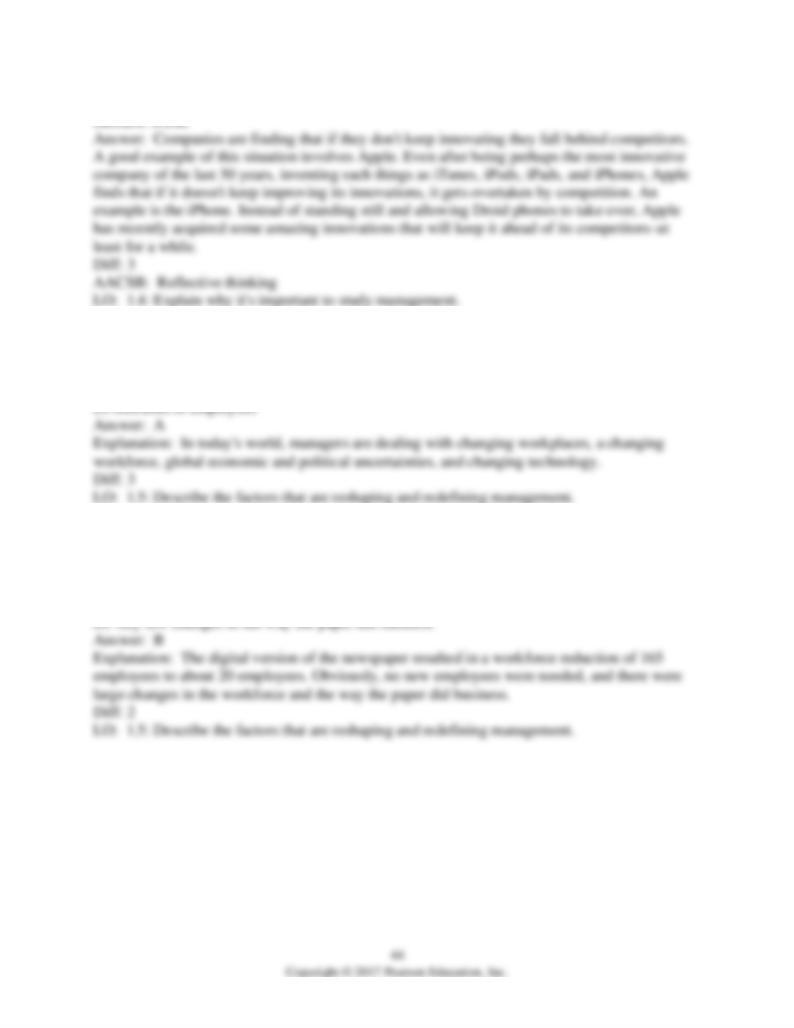
129) In a short essay, explain why innovation is becoming increasingly important in today's
130) A common factor that all managers face in today's world is the ________.
A) changing nature of work
B) lagging development of technology
C) demand to move to a production based economy
131) The decision of the Seattle Post Intelligencer newspaper to go "all-digital" resulted in
________.
A) managers needing to hire new employees
B) managers needing to drastically reduce their workforce
C) no workforce changes, but changes in the price of the paper
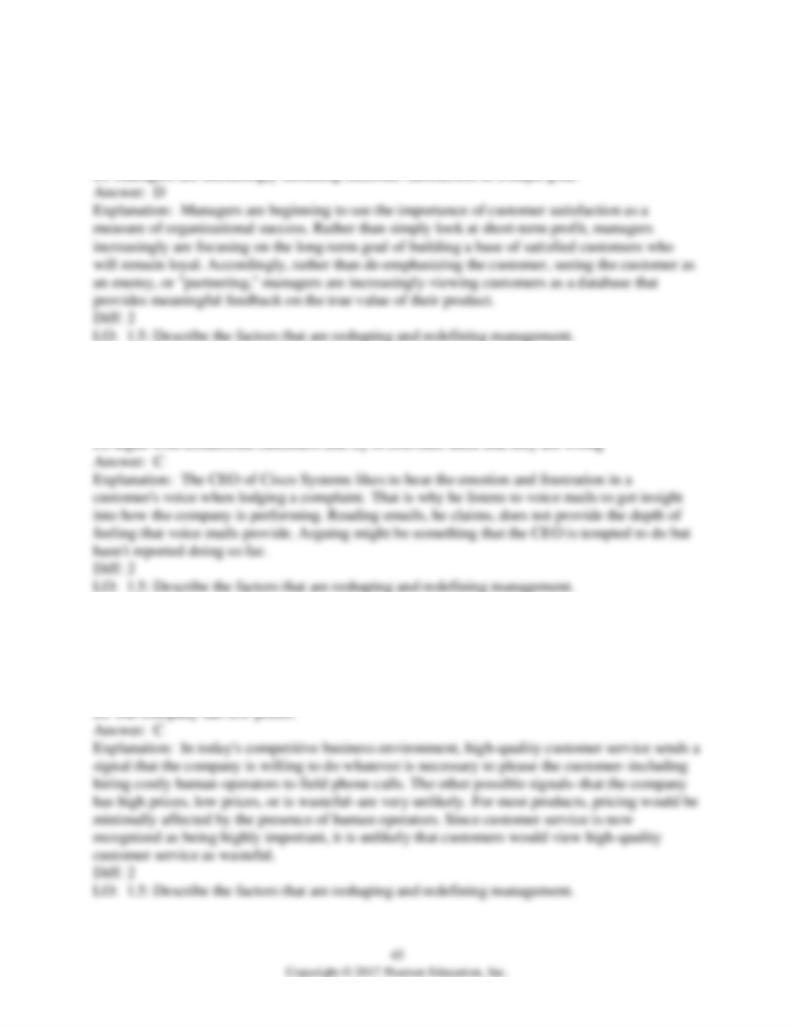
132) How do customers play a role in changing the job of the modern manager?
A) Managers are learning to think of customers as adversaries in a battle of survival.
B) Managers are inviting customers to take control of the planning and design of new products.
C) Managers are increasingly de-emphasizing customer satisfaction as a major goal.
133) The CEO of Cisco Systems likes to ________.
A) read emails from satisfied customers
B) listen to voice mails from satisfied customers
C) listen to voice mails from dissatisfied customers
134) What does a company's prompt, courteous, and helpful answering of a telephone with a
human operator signal to the customer who is calling?
A) The company has high prices.
B) The company is wasting resources on telephone operators.
C) The company is responsive to the customer's needs.
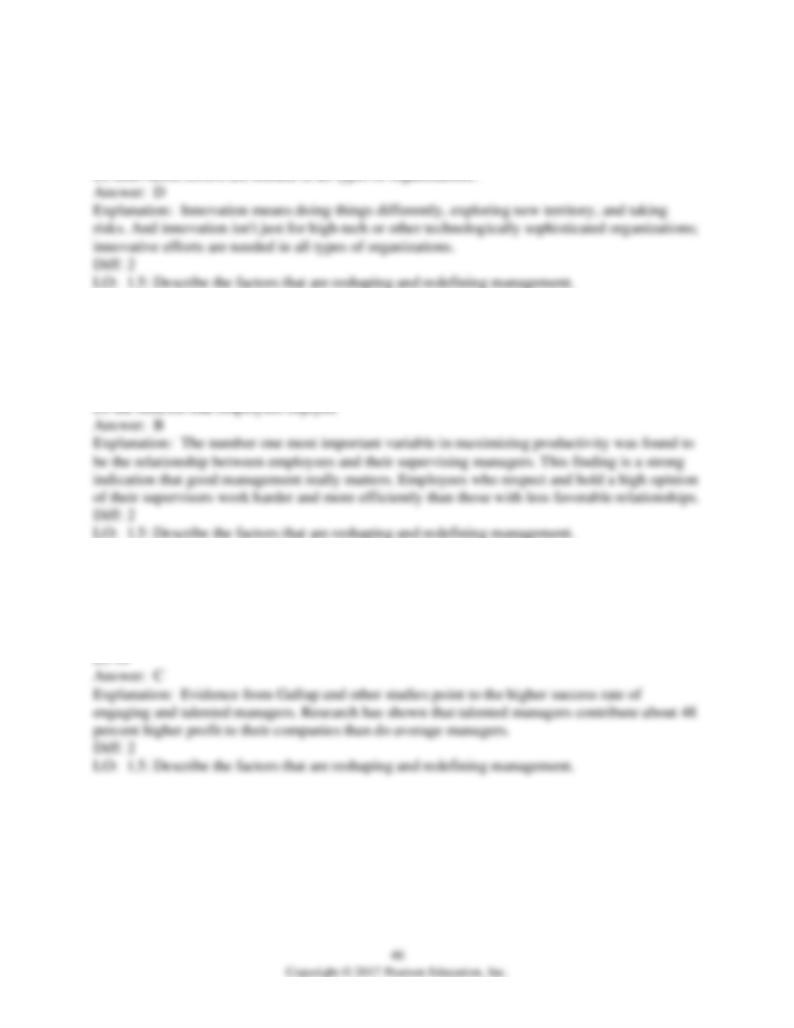
135) Why is innovation a key component of a manager's job in today's business environment?
A) Innovation keeps employees on their toes.
B) Innovation gives companies a "fresh" image without changing much real substance.
C) New approaches are always superior to old approaches.
136) Which of the following did a Gallop poll find to be the most important variable in employee
productivity?
A) pay level
B) quality of the employee-supervisor relationship
C) quality of the workplace environment
137) Research has shown that talented managers contribute about ________ percent more to
profit than average managers.
A) 10
B) 25
C) 50
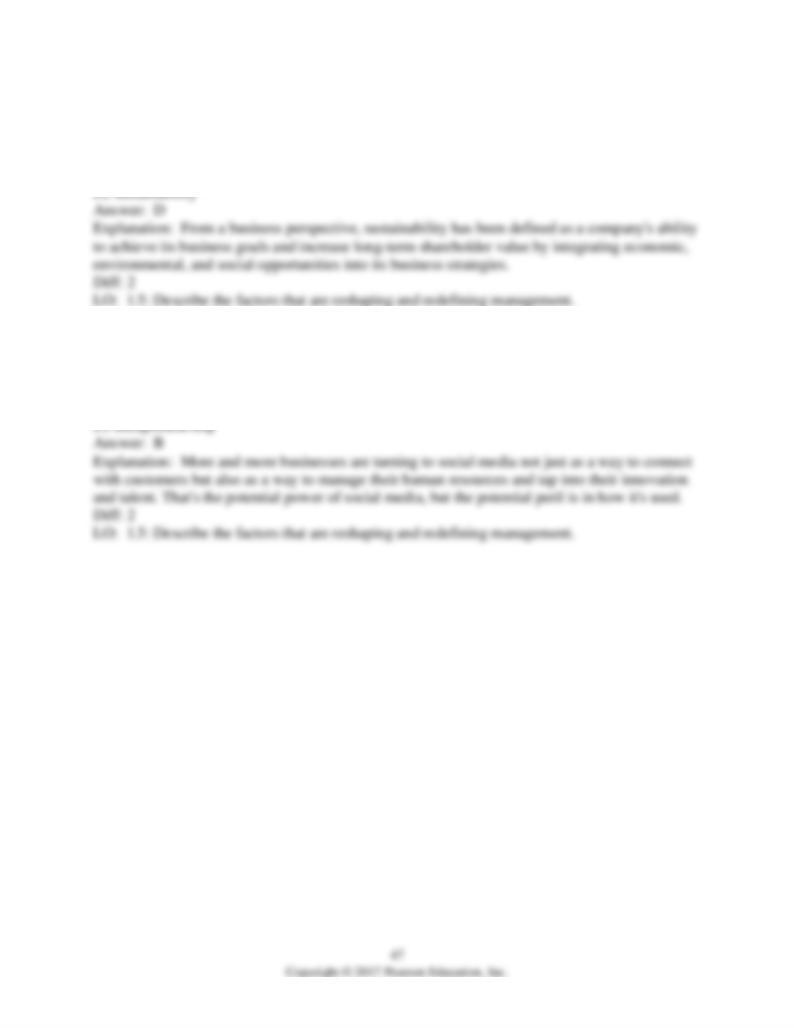
138) Which management challenge refers to management's responsibility to be attentive to
environmental and societal challenges?
A) social media
B) politics
C) managerial ethics
139) Described as the new frontier, this new challenge for managers has the potential to both
boast and drain employee productivity.
A) organizational politics
B) social media
C) environmental activism